|
Films marked † are known to exist; this indication is not complete.
Films marked * are included in The Movies Begin: A treasury of early cinema 1896-1906, Volume 2 (The European Pioneers).
• 1896
 ¶ Robert W Paul:
On Brighton Beach (July) †
—The first film shot in Brighton View online
¶ Birt Acres:
Brighton on a Bank Holiday (August)
—King's Road and the West Pier
Landing at Low Tide (August)
Scrambling Urchins (August)
¶ Esmé Collings (all 40ft):
 Bathers on the Beach at Brighton (summer) Bathers on the Beach at Brighton (summer)
Bicycle Rider*
Boys Under Pier (alt title Boys scrambling for pennies under the West Pier Brighton) (August) †[right, Picture source: BFI]
The Broken Melody* (October).
—A simple story film based on a stage melodrama, featuring Auguste van Biene, who was appearing at the Eden Theatre, North Road, in the week 28 September-3 October 1896.
Children on the Beach*
Children Paddling (alt title Children Playing in the Sea)* (August) †
Crowds At Brighton*
 Donkey Riding (summer). [right] Donkey Riding (summer). [right]
Dyke Station (alt title Train arriving at Dyke Station) †;
—re-creation of the famous Lumière film, demonstrating Collings’ awareness of the films made for the Cinématographe. This film can be seen at Hove Museum.
Hose Scene (alt title Comic Scene).
—Re-creation of another famous Lumière film, L’arroseur arrosé
King's Road Brighton (alt titles Brighton Front on a Bank Holiday and The Promenade at Brighton)* (August).
Musical Party, Van Biene (October) see also The Broken Melody above.
Policeman and Cook (alt title Love Scene)*. Comedy.
Rough Sea alt title The Hove Sea Wall in a Gale and Ocean Waves in a Storm.*
Street Scene.*
West Street Brighton alt title A Street in Brighton*.
¶ Esmé Collings away from Brighton:
Crowd at Law Court.
Crowded Streets in London.*
Czar in Paris. Two films, 6-8 November.
English Cavalry in Aldershot. Two films.
The Lord Mayor's Show* (9 November).
Military Scene.*
Portsmouth: The Ferry.*
Runners at Gatwick.*
Sailors of an English Warship.
Soldiers in Portsmouth (alt title Soldiers Landing.*
A Street in Portsmouth*
Street Traffic in London*
Westminster Bridge*
Workmen Leaving Portsmouth Dockyard*
*These films were offered for sale in Germany in January 1897 by Romain Talbot. a Berlin distributor.
• 1897

¶ Esmé Collings:
A Victorian Lady in Her Boudoir (alt title Woman Undressing) [right]
—Possibly the first ever 'blue movie', designated in the catalogue as suitable only for gentlemen's smoking parties. The lady removes her dress, some petticoats and nether garments and one stocking [right, Picture source: BFI] View online
Simon the Cellarer
—Three films commissioned by Lewis Sealy for showing during live stage shows with singers performing the well-known song. Distributed by Philipp Wolff.
Tomorrow will be Friday.
—Commissioned by Lewis Sealy.
¶ Robert W Paul.
Rottingdean Electric Railway (R W Paul). Volks Railway. Daddy-longlegs
railway (see also in G A Smith listing below).
¶ G A Smith for GAS Films:
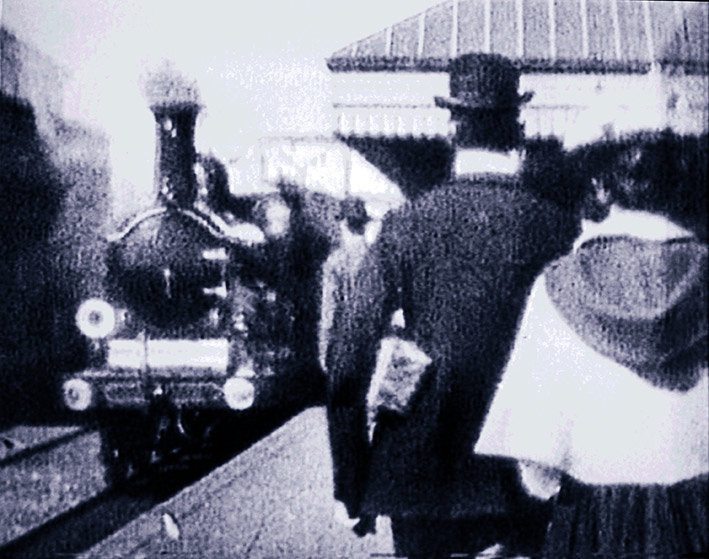 
Arrival and Departure of a Train at Hove † 1 min (75ft). [above left]
—A copy of the famous Lumière film,
Brighton Sea-going Car † [above right]
—Magnus Volk's Daddy-Longlegs railway, which ran through the sea between Madeira Drive (Banjo Groyne) and Rottingdean. It was new when filmed, having opened on 28 November 1896. It closed in the summer of 1900. A copy of this film was discovered in 2008 by the Filmoteca de Catalunya. View online
—A modern CGI animation by Conor Gorman of the tramcar itself can be seen on YouTube (opens in new window).
Brighton Sea-going Car no 2.
—Volks Daddy-Longlegs Railway.
Children Paddling at the Seaside 50ft
 
Comic Face (alt title Man Drinking) fiction 50ft. [above left]
—features Brighton comedian Tom Green. View online
Comic Shaving (alt title Comic Barber) (September) 50ft. [above right]
—features Tom Green and W Carlile. View online
 Football and Cricket 75ft.
Football and Cricket 75ft.
Football Game and Scrimmage 75ft.
Gymnastics series: Indian Club Performer (50ft or 75ft), Squad with Horizontal Bar (75ft), Squad with Vaulting Horse (75ft).
Hanging Out the Clothes (alt title Master, Mistress and Maid) † 1 min [right]
—possibly 1898.
The Haunted Castle fiction 50ft.
The Maid in the Garden comedy 50ft.
—features Tom Green and Nellie Gordon (Mrs Green).
  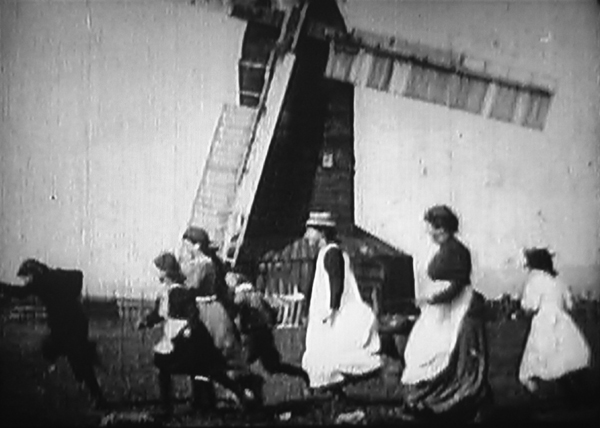
Making Sausages (alt title The End of All Things) (December) 50ft. [above left]
—Four men making sausages stuff all sorts of things—a cat, a rabbit, boots, etc—into the hopper of their machine. View online
The Miller and the Sweep 50ft.
—A miller leaving his mill with a sack of flour encounters a sweep with a sack of soot. They attack each other with their sacks until both are chased by a motley group (one man, two women, six boys and four girls), who appear from off-screen for no apparent reason but it adds to the excitement.The miller is played by music hall comedian Fred Hutchins, who later became the first mentor of Gracie Fields. The windmill looks like Jill, one of the two Clayton mills. According to an entry in his cashbook for 24 July, Smith tipped 2s 6d to start the mill. He also paid the two men 10s each and spent 4s on flour, props and refreshments.
The Miller and the Sweep no 2 (US title The Miller and Chimney Sweep) † [above right] 52ft.
—It is presumed the previous shoot was unsatisfactory as this is the second version. This time starting the mill cost 3s, refreshments 2s, flour and sweep’s tools 2s 6d. The two men again received 10s each (cashbook, 24 September). Released in the US by S Lubin and Edison, January 1903. View online
Mohawk Minstrels 75ft.
—‘Showing an audience leaving the West Pier Pavilion, following Messrs Danvers and Schofield of the Mohawk Minstrels, who, in full costume, amuse the surrounding crowds by cutting many funny capers’ (Warwick catalogue). Johnny Danvers and Johnny Schofield were two of the most popular music hall performers of the day, appearing on the West Pier 12-24 July 1897. The film is sometimes dated February 1900.
Nursing the Baby comic 50ft.
—Possibly made in 1898.
Passenger Train 75ft.
Portsmouth Express 75ft.
—Filmed at Southwick.
Sailing and Car 75ft.
Sailing Boat (by end of May).
The Sign Writer (alt title The Awkward Sign Writer) trick 50ft.
—Shows a sign writer painting a sign and then uses reversed motion to show him erasing the sign.
Tipsy-Topsy-Turvy trick 50ft.
—‘A reveller comes home from his club, and throws down his hat, stick and other garments. The articles all return to him, and he goes out of the room backwards.’ (Warwick catalogue). Reverse motion is achieved by turning the camera upside down and then projecting the film with the correct image orientation; this was possible because silent film geometry was laterally symmetrical.
Walking the Greasy Pole 75ft.
Weary Willie fiction 50ft.
—features Tom Green as the tramp, ‘engaged to beat carpets, beats employer by mistake, and sits down to smoke. Carelessness and laziness punished by pail of water.’ (Warwick catalogue)..
 
Workers Leaving Brighton Railway Station. [above left]
—The local equivalent of the Lumière film, La sortie de l'usine Lumière à Lyon. A bustling scene of people, horses and carts. The railway works were just to the north-east of the station. This was probably shot in Station Street, looking towards the top of Cheapside.
The X-ray Fiend (alt title The X-Rays) (October) 54ft. [above right]
—features Brighton comedian Tom Green and Smith's wife Laura Bayley. This may have been inspired by James Williamson's acquision of an X-ray machine in connection with his pharmacy practice. A man points a camera labelled ‘X rays’ at a couple. By employing a jump cut after the two characters are established, Smith transforms them into skeletal figures. The 'spoiled' frames at the cut are removed by splicing. Filmed October 1897. ‘The Professor turns his apparatus upon the lovers and makes a startling revelation. Very surprising and amusing.’ (Prestwich catalogue, 1898). A copy was rediscovered by the National Film and Television Archive in 1999. Tom Green was paid 13s for his performance. View online.
¶ G A Smith away from Brighton:
Love on the Pier (alt title Lively Scene on Hastings Pier).
—‘A lady is seen flirting with a young man both seated on the pier bench, when the husband puts in an unexpected appearance with a resulting climax.’ (Warwick catalogue). Although Smith might be expected to film one of the two piers in Brighton, the alternative title suggests otherwise. He was a regular optical lantern performer on Hastings pier.
Miss Ellen Terry series: Afternoon Tea (75ft), At Her Window (75ft), Gathering Flowers (75ft).
—The great actress was filmed at home in Winchelsea.
Pierrot Troupe (alt title Minstrels at the Sea-side 75ft.
—Filmed at Margate.
Queen Victoria's Diamond Jubilee Procession: Colonials (22 June) 75ft.
Queen Victoria's Diamond Jubilee Procession: Queen's Carriage (22 June) 75ft.
Trafalgar Day (alt titles Nelson's Monument and Trafalgar Square on Nelson Day) (21 October) 75ft.
Waves and Spray (alt title Study in Waves and Spray) 75ft.
—As with Love on the Pier and Yachting, probably made during a visit to Hastings with his magic lantern show.
Westminster (May) 75ft.
Yachting (alt title Sailing Yachts at Hastings) 150ft.
¶ James Williamson:
 Early Fashions on Brighton Pier † (alt title: Scene on the West Pier). [right]
Early Fashions on Brighton Pier † (alt title: Scene on the West Pier). [right]
—This was at one time attributed to Smith, but the boys in the foreground are unmistakably Williamson's sons. However, as Frank Gray has noted, the lampost in the background does not correspond with those found on a pier in Brighton at that time—nor any south coast pier. View online.
Fox-and-geese 75ft.
Hove Coastguards at Cutlass Drill 75ft.
Hove Coastguards at Flag Drill 75ft.
Ring-a-ring of Roses 75ft.
• 1898
¶ G A Smith for GAS Films:
Ally Sloper 75ft.
—Possibly the first ever film based on a cartoon character, which originated in 1867 and was immensely popular in comic form. James Williamson also made an Ally Sloper film.
Animated Clown Portrait 75ft.
—‘A portrait of a clown, just finished by the artist, gradually becomes animated, and the extraordinary grimaces produced scare the artist almost out of his wits.’ (Warwick Trading Company catalogue).
Animated portrait—Miss Marie Lloyd 50ft.
—The famous music hall artiste meeting a friend who arrives in a dog cart outside the Alhambra theatre (later the Palladium cinema) on King's Road, where she appeared on 25-30 July.
The Baker and the Sweep 75ft.
—Tom Green plays the baker, G Andrews plays the sweep. ‘Another soot and flour fight outside the house where the baker is delivering his goods. The servant of the establishment puts a damper on the fury of the combatants by means of a pail of water. ’(Warwick catalogue).
Brighton: Children on the Sands (sands!) 50ft.
Brighton: The Esplanade 50ft.
—A man buys a button-hole from a girl illegally selling flowers, who is then moved on by a policeman.
Brighton: The Lower Esplanade 50ft.
Brighton: The Launch of the Skylark 50ft.
Cinderella and the Fairy Godmother (alt title Cinderella) (July) 75ft.
—Possibly the first use of double exposure and stop-action (in-camera jump cut) transformation. Laura Bayley plays Cinderella. ‘Cinderella, sitting dejected by the fireplace, is visited by the Fairy Godmother, who shows her on the wall a beautiful vision of the Prince dancing a minuet with her at the Palace. The dance is most gracefully executed, and is in itself a most pleasing moving picture. When the vision disappears, Cinderella shows that she cannot go to the ball in such old rags, whereupon Fairy Godmother miraculously changes her dress. She despatches Cinderella, then mounts her walking stick and takes flight up the chimney.’ (Prestwich catalogue). The French film-maker Georges Méliès made a version (Cendrillon) the following year.
Clown (18 October)
—Advertising film for Messrs Rae Bros, 134 St Vincent Street, Glasgow.
The Corsican Brothers (July) 75ft.
—Innovative use of a vignette within the frame to show a flashback, achieved by winding the film back in the camera and making a double exposure. ‘One of the twin brothers returns home from shooting in the Corsican mountains and is visited by the ghost of the other twin. By extremely careful photography the ghost appears quite transparent. After indicating that he has been killed by a sword-thrust and appealing for vengeance, he disappears. A “vision” then appears showing the fatal duel in the snow. To the Corsican’s amazement, the duel and death of his brother are vividly depicted in the vision and finally, overcome by his feelings, he falls to the floor just as his mother enters the room.’ (Warwick catalogue, 1900). This could be the first ever literary adaptation on film, inspired by Alexandre Dumas’ story (which was filmed in 1941 with Douglas Fairbanks Jr). [0067]
Cycle Boat (alt title The Water Cycle at Sea).
—‘A novel method of propulsion over the water. The water cycle is ridden over the waves breaking on the shore, goes out to sea, and returns, passing the camera very closely, thereby disclosing the details of construction of this unique craft.’ (Warwick catalogue). Surely the first ever record of a pedalo.
The Dog Show 50ft.
Faust and Mephistopheles (September) 75ft.
—‘Faust discovered in his study. Mephistopheles appears in a cloud of smoke (fine effect), offers Faust renewal of youth if he will sign bond. As inducement shows him charming moving vision of Marguerite at spinning-wheel in the garden. Faust hesitates no longer; signs bond! Mephistopheles triumphantly waves drinking cup, causing it to emit a cloud of smoke, which falls around Faust as he changes to a handsome young man.’ (Prestwich catalogue).
Fight (November).
Girls Bathing (November).
Gymnastics three parts: horizontal bar, parallel bars, vaulting horse.
The Lady Barber (alt title The Woman Barber) 75ft.
—‘Her want of skill is atoned for by her dexterity as a surgeon. Her customer’s face is finally covered with sticking plaster, yet he seems to thoroughly enjoy the innovation’ (Warwick catalogue).
Maypole Dance (July) 75ft.
—Williamson shot a similar film around the same time.
The Mesmerist, or Body and Soul trick (October) 75ft.
—‘ “Professor Fluence” in his study is visited by old lady who wishes to see some “Mesmerism”. Professor mesmerises little girl and proceeds to draw her “spirit” from her body. Little girl’s spirit leaves body and walks over the furniture. “Spirit”, which is quite transparent, is finally conducted back to the body, and the mesmerist awakens hissubject, much to the relief of the old lady.’ (Prestwich catalogue). Earlier, Smith had a mesmerism stage act.
Phantom Ride (May) 75ft.
—Possibly not issued.
Photographing a Ghost (September) 75ft.
—‘Shows what can be done by an enthusiastic amateur with a 4x5 Kodak. The picture reveals the artist with his camera in position. Two men come in with a trunk, labelled GHOST. The photographer carefully opens the trunk, and up rises a tall, white Thing. It glides around, and just as the artist is ready, it disappears. He is greatly mystified; and more so than ever, when the ghost reappears, apparently from nowhere, and after floating around, steps back into the trunk. The photographer promptly sits on the lid and locks it with an air of relief. He gets up, turns around, and there stands Mr. Ghost, behind him. The ghost becomes active, and chairs are thrown around in a very lively fashion. The photographer finally sinks down in despair and gives up the job.’ (Edison catalogue) Smith would have been familiar with the stage illusion called ‘Pepper’s Ghost’, apotential inspiration. Released in the US by SLubin and Edison, May 1900.
The Policeman, the Cook and the Copper (alt titles The Policeman and the Cook, The 'Copper' in the Copper) 75ft.
—features Tom Green; from the one-act farce Area Belle, or Fun in the Kitchen (1864) by William Brough and Andrew Halliday. ‘Servant, unfortunately, conceals her Bobby in the copper a few minutes before “Missus” decides tocommence washing.’ (Warwick catalogue).
A Practical Joke (alt titles A Joke on the Gardener, Gardener with Hose) comic 50ft.
—A remake of Lumières' L'Arroseur Arrosé)
The Runaway Knock comic 50ft.
—‘Several urchins knock on an old lady’s front door and run away. A tiny child anxious to “have a go” at the knocker, is too short to reach it. A kindly old gentleman who happens to pass lifts the little one up and is rewarded for his pains by the irate householder, who suddenly emerges and deluges him with a pail of water.’ (Warwick catalogue).
  
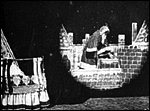  
Santa Claus (alt title The Visit of Santa Claus) † (September) 75ft.
—The maid helps the children to hang up their Christmas stockings as they go to bed. Smith uses a jump cut to ‘turn out the light’: a black drape replaces the wall and double exposure is used to superimpose a vignette of Santa arriving on the roof as the children sleep. He comes down the chimney, emerging in the room to put presents in the stockings, then waves before disappearing. One of the most important films yet made, it uses double exposure (cf The Corsican Brothers, above) to show the scene on the roof as the children sleep. Included in the print is a lettered title and a handwritten frame inscribed 'Protected under the patent laws GAS'. View online.
The Ungallant Lover 50ft.
—Comic romance filmed at a boat on the beach.
Waves and Spray.
• Seven of the above titles were directed by G A Smith for the Warwick Trading Company (manager: Charles Urban) and included in its October 1898 catalogue. Warwick was a sales agent for G A Smith but it also handled the work of others and commissioned some films on its own account.
¶ G A Smith for GAS Films, shot away from Brighton.
Comic Costume Race (alt title Music Hall Sports) 75ft.
—Filmed at Herne Hill, London.
Gladstone's Funeral 75ft.
—Filmed in London on 28 May.
The Grand National.
—The race was run on 25 March.
Portsmouth Ferry, actuality (November).
¶ James Williamson:
Ally Sloper Batting (October/November).
 Another of the Same (alt title Lady Cyclists) (July) 75ft.
Another of the Same (alt title Lady Cyclists) (July) 75ft.
—sequel to Military Ride by a Lady Cyclist.
Bank Holiday at the Dyke (August) 115ft. [right]
—Scenes of the fairground at Devil’s Dyke: swings, roundabouts, a tracked cycle race and a wooden roller-coaster ride over an undulating course. View online.
Barnum's Procession (September) series: Elephants (75ft), Elizabethan Cavalcade (75ft), Forty Horses and Band Car (75ft), Landing of Columbus (75ft), Volunteers (75ft).
—Filmed on Hove seafront.
Children Bathing on Hove Beach (July/August) 75ft.
The Clown Barber (July) 70ft.
—‘Gentleman enters barber’s shop, knocks and takes a seat. Clown enters, to evident consternation of customer, dances round, and proceeds with the shaving, using a large bowl and brush; lathers him, and then producing a huge razor, commences to shave, but the gentleman becoming alarmed, and rather restive, cuts his head off, and finishes the operation at the sideboard; puts the head on again; customer gets up, expresses his entire satisfaction at the success of the operation, pays and departs’ (Williamson catalogue).
Clown Cricketers (alt title Clever Cricket) (July) 72ft.
Cricket (alt title Sussex County Cricketers) † (July) 100ft.
— ‘At practice in Hove Cricket Ground’, features W G Grace and Prince Ranjitsinhji in the nets, the Sussex XI taking the field and Lord Hawke coming in to bat. Ranji played for Sussex, Dr Grace played for Gloucestershire and Lord Hawke for Yorkshire. How they came to be together is unclear.
Cycle Parade 70ft.
Fire Brigade Sports series: Dressing Competition (72ft), Life Saving Demonstration (65ft), Tilting the Bucket (50ft)
—Made with the co-operation of Hove Fire Brigade.
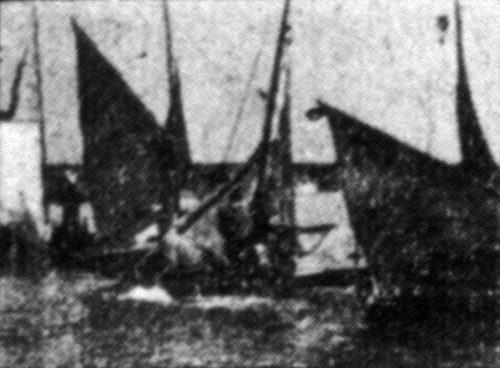 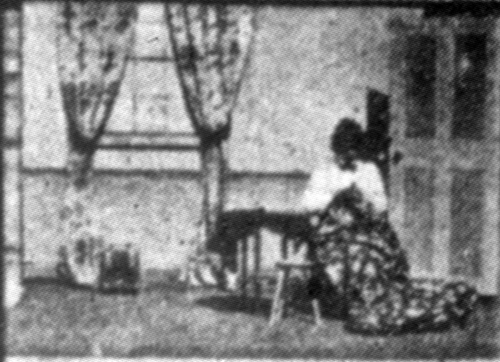
Fishing Smack Race (August/September) 70ft. [above left]
The Forbidden Lover 65ft .[above right]
—Williamson appears as the father.
The Fraudulent Beggar (August/September) 65ft.
—‘An interval in business—blind man reads a comic paper and deaf mute enjoys a joke; discovered by policeman’ (Prestwich catalogue).
Highland Fling 75ft.
The Jealous Painter (August/September) 60ft.
—‘Whitewashing a rival’ (Prestwick catalogue).
Lawn Tennis 60ft.
Maypole Dance (alt titles Children Plaiting the Maypole, Children Dancing Round Maypole) 66ft.Smith shot a similar film around the same time.
Military Ride by a Lady Cyclist (alt titles: Ladies Cycling, Military Ride by a Woman Cyclist) 75ft (July).
—See also Anaother of the Same above.
Military Sports series: Bayonet Exercise (75ft), Dumb-bell Exercise (75ft), Horizontal Bars Display (70ft), Hurdle Jumping (75ft), Musical Ride (66ft), Parallel Bars Display (70ft), Plaiting the Maypole (75ft), Tent Pegging (102ft).
Minuet 75ft (May?)
—'By 12 girls.'
Miss Norah Mayer, the Quick-Change Dancer (September)
—Three parts totalling 225ft.
Procession of Sunday School Children 75ft.
—Probably filmed at Whitsuntide (29 May).
Sailing Boats (September) 75ft.
Sir Roger de Coverley 50ft (July)
—Children dancing.
Sloper's Visit to Brighton (July)
—three parts A, B, C, 210ft.
Switchback Railway 40ft.
—Part of the Bank Holiday at the Dyke sequence [qv above] but also offered separately.
Sword Dance 75ft.
Trip in 'Brighton Queen'
A 'Leaving the pier' (July) 75ft.
—in Brighton.
B 'Passing the Cruiser Crescent' (July) 75ft.
—Filmed at sea at Cowes Regatta.
C 'Arrival at Cowes Regatta' (July) 75ft.
—Filmed at sea at Cowes Regatta.
Two Naughty Boys Sprinkling the 'Spoons' (July) comic 75ft.
—'A new version of the garden-hose scene.' The two boys are Williamson's sons, Alan (12) and Colin (10). Their two younger brothers appear in a later version by Dave Aylott in 1909 [qv]. For unexplained but intriguing reasons, the victims are called Spoon.
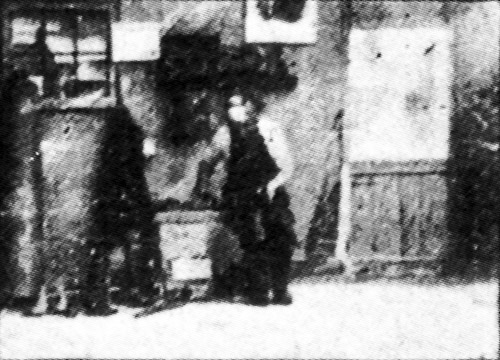 
Two Naughty Boys Teasing the Cobbler (July) comic 68ft. [above left]
—features Williamson's sons Alan and Colin.
Two Naughty Boys Upsetting the 'Spoons' (July) 66ft. [above right]
—features Williamson's sons Alan and Colin. The 'two naughty boys' theme was copied by Edwin S Porter for Edison in 1906.
Volunteers three parts, each 75ft.
—‘Position battery drill’; ‘Field gun firing and limbering up’; 'Big gun firing; old muzzle-loading gun in redoubt at Shoreham Harbour.'
 Washing the Sweep † (July) 75ft [right].
Washing the Sweep † (July) 75ft [right].
—features Marie Mayhew as one of two women whose washing is messed up by a sweep. They catch the sweep and one of the women scrubs his face. He escapes and chases the other woman. Probably inspired by G A Smith’s Hanging out the Clothes (1897)..
Winning the Gloves (US title Winning a Pair of Gloves) 75ft (July)
—A man, played by Williamson, pretends to be asleep so that a girl will kiss him. However, she brings along a donkey to ‘kiss’ himinstead. The title comes from a popular story byWilliam Henry Harrison and a later comic ballad. Released in the US by Kleine, November 1905.
¶ James Williamson away from Brighton
Country Life Series
Blacksmiths at Work 75ft.
Harvesting (September) 67ft.
—67ft).‘Shows three men at work in the harvest field. Cutting with hook, binding and stacking sheaves, and a pause for refreshments’ (Prestwich catalogue).
Horses Ploughing 70ft.
Oxen Ploughing 65ft.
Sheep Washing 75ft.
A Sussex Ox Wagon 54ft.
Diving 119ft.
—Filmed at Rye Regatta.
Express Train and Level Crossing 75ft.
—Filmed at Lancing railway station.
Henley Regatta series: Crowd Inside the Booms (75ft), Crowded Course (75ft), Enclosure, Clubs and Towing Path (75ft), Four Oar Races (70ft), Greasy Pole (70ft), Houseboats (75ft), Left Bank (75ft), Panorama of the Course (75ft), Water Polo (75ft).
Threshing Turnip Seed at Rye, Sussex (alt title: Seed Threshing) 75ft.
¶ R W Paul had a film of Brighton in a set of seven shorts called Street Scenes, which may have been shot in the first half of this year.
|
|
• 1899
¶ John Benett-Stanford away from Brighton:
Churned Waters 30 secs.
—View of ship's wake, probably en route to South Africa. View online.
First Northumberland Fusiliers Digging Entrenchments (12 November).
—Filmed in South Africa during the Boer War. View online.
Lancers Under the Earl of Airlie Fording the Modder River (8 December).
—Filmed in South Africa during the Boer War. View online.
Panorama of Calcutta, India, from the River Ganges. 162ft.
—Despite the title, filmed at Varanasi. View online.
Troops Passing Over the Modder by Train (8 December). 19ft.
—Filmed in South Africa during the Boer War. View online.
¶ G A Smith:
Aladdin and the Wonderful Lamp 75ft.
All the Fun of the Fair 50ft.
Brighton 75ft.
Dick Whittington 75ft.
The Gambler's Wife 75ft.
A Game of Chess and Kisses 75ft.
A Good Joke 75ft.
—features Tom Green and J D Hunter. The latter was the manager of the Pier Pavilion at Hastings, where Green was a regular performer.
Good Stories 100ft.
—features Tom Green and J D Hunter.
The Haunted Picture Gallery 75ft.
The Inexhaustible Cab (October) length variously given as 75, 90, 95 or 130 ft.
—‘A cab is hailed in front of a palatial mansion by a gentleman who wishes a score of people driven to another part of the city. A clown jumps out and a satisfactory agreement is made between the clown and the gentleman, and a score or so of persons are hustled in one at a time until the clown succeeds in piling in the whole lot except Bridget, who is carrying a child. The persistent clown, in order to assist the nurse, who tips the scale at 400 pounds, takes the child from her. After caressing it he tosses it on top of the cab. He then picks up a board and uses it with good effect on the extremities of the fat woman, until she is forced into the cab, which drives away with its load of humanity’ (Edison catalogue). Released in the US by Lubin and Edison, 29 June 1901. View online.
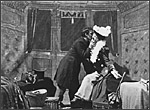 The Kiss in the Tunnel †* 1 min 14 secs (inserted section: 40ft) [right] The Kiss in the Tunnel †* 1 min 14 secs (inserted section: 40ft) [right]
—One of the earliest examples of creative editing: Smith takes an existing film by Hepworth of a train entering a tunnel (a popular genre known as the phantom ride), cuts to the interior of the train as a man (a rare—unique?—appearance by Smith himself) kisses a woman (Mrs Smith) and then cuts back as the train leaves the tunnel. The kissing scene, of course, is well lit to make it visible. The backcloth was painted by Tonm Green. Released in the US by American Mutoscope and Biograph Company April 1903. View online.
Launch of the Shamrock 75ft.
The Legacy 75ft.
The Sandwiches (alt title The Hungry Countryman) 75ft.
¶ G A Smith for the Warwick Trading Company:
 Around the Swings on a Bank Holiday 50ft.
Around the Swings on a Bank Holiday 50ft.
Brighton Fire series: A Brighton Fire Call (50ft), The arrival of the fire brigade (75ft), The department at work (100ft). [right]
Fire and Police Obstacle Race series: Over the Tower (50ft), Through Tubs (50ft), Under Blankets (50ft).
Fire Drill series: Arrival of Hose Cart (50ft), Life Saving by Rope and Sling (75ft), Rescue from Tower By Escapes (50ft).
A Hilarious Bank Holiday Crowd* 50ft.
Kaffirs and Zulus on the Warpath*.
Police Officers Full Uniform Dress Race* 50ft.
Savage South Africa at Earl's Court* 50ft.
The Swings at Crystal Palace* 50ft.
*AWay from Brighton
¶ James Williamson:
Courtship Under Difficulties 67ft.
—features Florence Williamson, the director's 14-year-old daughter.
The Jovial Monks No 1 72ft.
—features (D) Philippe [above left]
The Jovial Monks No 2: Tit for Tat 54ft.
—features (D) Philippe [above left]
The Sleeping Lovers 60ft.
Tearing
Tug o' War
• 1900
¶ G A Smith for GAS Films:
The Adrian Troupe of Cyclists 150ft.
 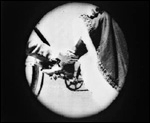
As Seen Through the Telescope (US title The Professor and his Field Glass) †* 65ft or 75ft.
—Innovative use of a point-of-view cutaway in this three set-up comedy, filmed just outside the Furze Hill entrance to St Ann's Well Gardens. A gentleman in a top hat uses his telescope to spy on a man showing a woman how to place her foot on the pedal of a bicycle, revealing an ankle. In the third shot the gentleman sits on a camp stool as the couple pass behind into the gardens; the man pushes the gentleman over. Released in the US by American Mutoscope and Biograph Company April 1903. View online.
A Bad Cigar 75ft.
The Conjuror 50ft.
 The Dull Razor (alt title Difficult Shave) † 75ft.
The Dull Razor (alt title Difficult Shave) † 75ft.
—The camera looks over the shoulder of Tom Green shaving and gesturing, the camera operator’s arm being visible in the mirror. See also A Quick Shave and Brush-up below. View online.
Grandma Threading Her Needle 50ft or 75ft. [right]
—Said to feature Eva Bayley, that looks more like someone (Tom Green?) in drag. The cat features in several of Smith's films. Released in the US by Edison Manufacturing Company September 1902 View online.
 
Grandma's Reading Glass †* 100ft
—Another innovation: Smith experiments with big close-ups cut into a medium shot of the boy and his grandmother [pair of images above right]. Some sources attribute this film to Arthur Melbourne Cooper and claim it was only distributed by Smith, the actors being Cooper's mother, Catherine, and her grandson Bert Massey. View online.
Grandmother's Wolf
 
The House that Jack Built † 50ft.
—Jack knocks over the house of bricks his sister has made but when the film is reversed, as instructed by a caption, he appears to re-build the house. Released in the US by American Mutoscope and Biograph Company April 1903.
An Incident on Brighton Pier 50ft.
A Jolly Old Couple 75ft.
—features Brighton comedian Tom Green.
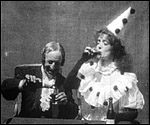 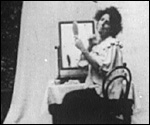 
Let Me Dream Again †* 75ft [above left]
—features Tom Green and (Laura Bayley). Technically important as the transition between the two shots involves de-focusing the first and bringing the second into focus to show the change from dream to reality —a technique still used today. Pathé copied the film in 1902 with a dissolve. View online.
Letty Limelight in Her Lair (alt titles A Lady at her Morning Toilet, Miss Bayley) 200ft [above centre]
—features Eva Bayley as an actress preparing in her dressing room.
The Old Maid's Valentine † 57 secs (alt title The Valentine) 50ft
—features Laura Bayley [above right] View online.
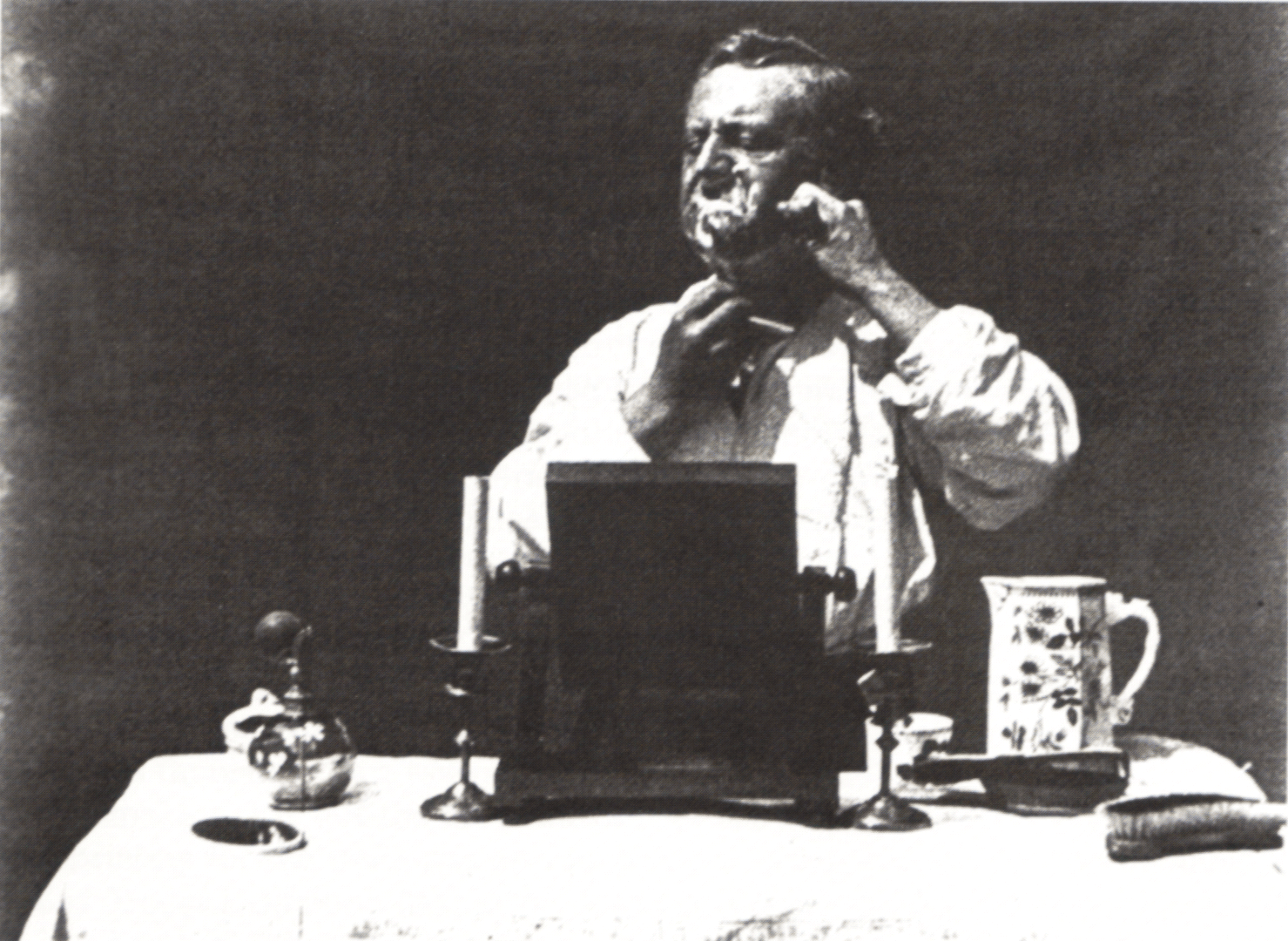  
A Quick Shave and Brush-Up [above left] 50ft.
—features Tom Green. 'As most men have had a similar experience [a painful shave], this subject is bound to create much mirth among an audience' [Warwick catalogue description]. View online.
Scandal Over the Teacups † [above right] 75ft.
—features Eva Bayley and Laura Bayley.
 Snapshotting an Audience 75ft.
Snapshotting an Audience 75ft.
Spiders on a Web † 15 secs. [right]
—Close-up of two spiders in a circular mask[Photo: BFI]
Topsy-Turvy Dance by Three Quaker Maidens † 72ft or 125ft.
—A comic film in which the three dancers in Quaker costumes go behind an American flag held by two men. They appear to be dancing upside down until the flag is lowered to show they are waving dummy legs. Also released in 1902 in a 17.5mm version called The Puritan Maiden’s Upside-Down Dance 20ft.
Two Grinning Yokels 50ft.
Two Jolly Old Fellows (alt title They Are Jolly Good Fellows) 100ft.
—features Tom Green and J D Hunter.
The Two Old Sports 50ft or 75ft.
—features Tom Green and J D Hunter. Released in US by Selig Polyscope January 1903. Copied by Edison as Art Studies in 1903 [0067].
The Two Old Sports' Game of Nap (alt title The Winning Hand) 125ft.
—features Tom Green and J D Hunter.
The Two Old Sports' Political Discussion 75ft.
—features Tom Green and J D Hunter.
The Village Choir 75ft.
Where Did You Get It? 75ft.
¶ G A Smith for Warwick Trading Company:
Eugene Sandow series: Beauty and the Sandow Exerciser (50ft), A Convenient Cigar Lighter (50ft), Physical Culture by Sandow's Pupils (75ft), Sandow's Herculean Feat (50ft), Sandow's Record Lift (75ft), Sandow's Roman Horse Lift (75ft).
—Sandow was a famous American strong man.
Exhibition of Quick Harnessing with Trained Horses 75ft.
—This may have been filmed with the following, as the Kansas City Fire Department set a record for harnessing horses in 1.5 seconds.
Kansas City Fire Department Drill 100ft.
—The KCFD team won the world championship at the International Fire Congress in Paris in 1900. The Kansas City fire chief, George Hale later became famous for Hale’s Tours: audiences seated in a stationary railroad car saw scenic films through the windows.
Launch of Brighton Lifeboat from Pier 100ft.
Panorama of the Lake and Its Surroundings (alt title Panorama of Crystal Palace Lake) 50ft.
Panorama View of Crystal Palace Terraces 100ft.
The Prehistoric Monsters at Crystal Palace 100ft.
¶ James Williamson for Williamson Kinematograph Company:
 Attack on a China Mission—Blue Jackets to the Rescue †* (released November) Attack on a China Mission—Blue Jackets to the Rescue †* (released November)
—A longer film than usual of 230ft (four minutes). The dramatic re-enactment of a recent incident in the Boxer rebellion in China. For its time a major production, comprising four set-ups with cutting between each. This is almost the certainly the first film ever to use the principle of what later is known as montage: cutting between shots to heighten the drama and to show reverse angles. Historian John Barnes wrote that 'this is one of the key films in the history of the cinema and had the most fully developed narrative of any film made in England up to that time'. The film was shot at the soon-to-be-demolished Ivy Lodge (where Vallance Gardens is now) with a cast of more than two dozen, including Ernest Lepard (newly-appointed manager of the Alhambra Opera House and Music Hall) as the missionary, Mr James and Williamson's 16-year-old daughter Florence, who worked at the time as an assistant in his shop, and authentic looking troops. The film was released in the USA on 28 November 1903. View online.
The Brighton Queen † 200ft.
—Pleasure cruise steamer of the Brighton, Worthing and South Coast Steamboat Company, which took passengers up and down the coast from the West Pier. View online.
Circular Panorama of Brighton Front 52ft.
—Both Williamson and Smith made several such simple views this year, of which this is the only one in Brighton.
Clever and Comic Cycle Act.
—features Lotto, Lilo and Otto, Champion Juvenile Bicyclists, who appeared at the Alhambra, King's Road in the week 10-15 December 1900. [These music hall artistes had appeared on London bills at Gatti's and elsewhere in the 1890s with Marie Loftus, who in this year became the first person to move to what became Bungalow Town.]
The Disabled Motor comedy. (November). 70ft.
Great Glove Fight 2 parts, 230ft.
La Marguerite 65ft.
The Sea-going Car 75ft
—Magnus Volk's Daddy Long-legs tram that ran through the sea from Madeira Drive to Rottingdean (previously filmed by both R W Paul and George Albert Smith in 1897, qv), This must have been filmed early in the year as the tramway closed during the summer of 1900 for repairs and was never able to re-open because of the construction of sea defences along its route.
Three Novel Railways 75ft.
—in Brighton, including Volk’s Railway, Daddy Long-Legs and the railway to Devil’s Dyke.
Volk's Electric Railway 44ft.
—Magnus Volk’s older (but still surviving) electric railway on Brighton beach from the Palace Pier to Black Rock, which opened in 1883.
¶ James Williamson away from Brighton (four titles, 10 films) for Williamson Kinematograph Company:
Circular Panorama of Windsor Castle 30 secs/30ft.
Military Tournament 800ft series: Bareback Riding (50ft), Bayonet Exercise (41ft), Gymnastic Exrcise on Chairs (70ft), Heads and Posts (30ft), Quarterstaff Display (62ft), Vaulting Horse Display (75ft), Wrestling on Horseback (45ft).
Panorama of Dover Harbour 50ft.
Panorama of Folkestone from the Pier 60ft.
• 1901
¶ G A Smith for GAS Films:
The Bill Poster's Revenge 50ft.
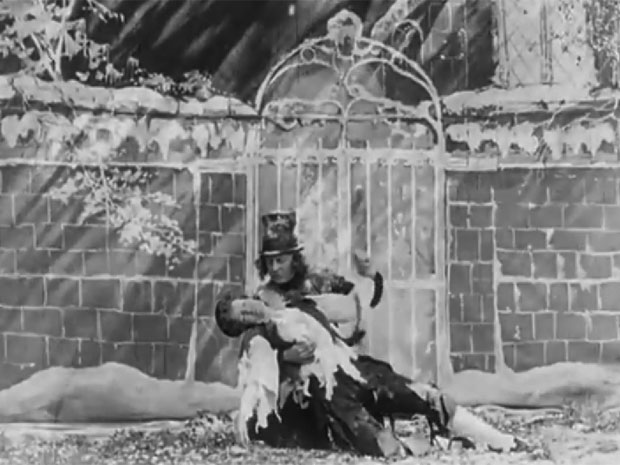 The Death of Poor Joe (March) 70ft. The Death of Poor Joe (March) 70ft.
—A scene from Charles Dickens' Bleak House in which the ragged crossing sweeper Joe (Laura Bayley) dies in the arms of the watchman (Tom Green). This is the earliest known film os a Dickens subject. Regarded as lost until a copy donated the the BFI by Graham Head in 1954 but incorrectly catalogued was rediscovered in March 2012. Shot with the bright sunlight through the trees streaking across the backdrop in St Ann's Well Gardens. View online.
Dogs in the Surf.
—Issued in a 17.5mm Biokam version.
A Good Story 50ft.
In the Green Room 100ft.
—Is this a different title for Letty Limelight in her Lair (1900) or at least shot around the same time and for a similar purpose as an entr’acte in a theatrical show?
The Kitten Nursery 100ft.
The Last Glass of the Two Old Sports50ft
—Another in the series featuring Tom Green and J D Hunter.
The Little Doctor and the Sick Kitten (alt titles The Little Doctor, The Sick Kitten) 50ft
—Remade in 1903 (see below).
The Monocle: Me and Joe Chamberlain 50ft.
—Described as a rapid cartoon sketch. A rare political reference in films of the period. Joseph Chamberlain was a Liberal MP and one of the most popular and influential politicians of his day.
A Photograph Taken from Our Area Window (alt titles Study in Feet and Story Told by Feet Only Seen Through Railings) † two shots, 44ft and 100ft.
—Probably directed by Laura Bayley, Mrs G A Smith. A number of legs are seen walking past the basement window. A most unusual—even avant garde—concept for a film at that time. Also released in a 17.5mm Biokam version.
Whisky versus Bullets 50ft.
¶ G A Smith for Warwick Trading Company:
Bicycle Race at the Crystal Palace 100ft.
Corpus Christi Procession at Naples 100ft.
Crystal Palace series: Incidents from the Battle of Trafalgar (50ft), Water Carnival (75ft), Water Pantomime (50ft)
London Street Scenes series. Hyde Park Corner Looking East; Pall Mall Looking East.
—Released as Pall Mall and Hyde Park Corner in a 17.5mm Biokam version.
Naples and Vesuvius 50ft.
Naval Demonstration: SS Ophir 50ft.
Panorama of Naples Harbour 50ft.
Pall Mall and Hyde Park.
Vesuvius in Eruption 50ft.
 ¶ James Williamson for Williamson Kinematograph Company:
¶ James Williamson for Williamson Kinematograph Company:
Are You There? (US title A Telephone Romance) (October) 75ft.
—features Sam Dalton. A telephone conversation between a young man and his girlfriend, shown in split screen (actually a set constructed on similar principles), is interrupted by her father. In a second shot the father attacks the young man with his umbrella. Released in the US by Biograph and Kleine, September 1902. View online.
Bicycle Polo 200ft.
—Sporting actuality.
  
The Big Swallow (US title A Photographic Contortion, alt titles: I Won't, I Won't, I'll Eat the Camera First, The Swallower) †* 60ft
—features Sam Dalton. Perhaps the first time that the camera becomes part of the action, rather than merely observing it, making it the first metafictional (self-referential) film. ‘A prominent actor with wonderful talent for facial contortion is standing some distance from the camera. As the film is set in motion, he walks toward the lens until his head grows into enormous proportions. He then stands so close to the camera that every wrinkle in his face, and in fact, the pores of his skin are plainly shown and greatly magnified. As he comes closer to the lens he opens his mouth wide, and is biting at the instrument all the while. He is then seen to swallow the camera, operator and all. He is next seen backing away from the instrument, smacking lips and rubbing his stomach in great glee. Very funny and a great hit.’ (Edison catalogue) Released in the US by Edison, September 1902. View online.
Cyclist Scouts in Action (October) 150ft.
—Wartime incident reconstruction.
The Elixir of Life 90ft.
—features Sam Dalton. ‘An old, grumpy-looking individual is seated behind a table, on which a black bottle and a tumbler is placed. From the expression on his face one would think he was suffering from a bad case of indigestion and he frowns on everything in sight. Suddenly he picks up the bottle, and, reading the words "Elixir of Life" on the label, he determines to sample it, thinking it may do him good. He uncorks it, and, pouring a thick, black liquid into the tumbler from the bottle, proceeds to drain the glass, but with no apparent relish. He perseveres, however, and finally empties the bottle, when, lo, he is changed into a young and healthy man, and by his action one can readily understand that he recommends the Elixir to all who would be young and healthy’. (Lubin catalogue) Released in the US by Biograph, Kleine and Lubin, 1 August 1903.
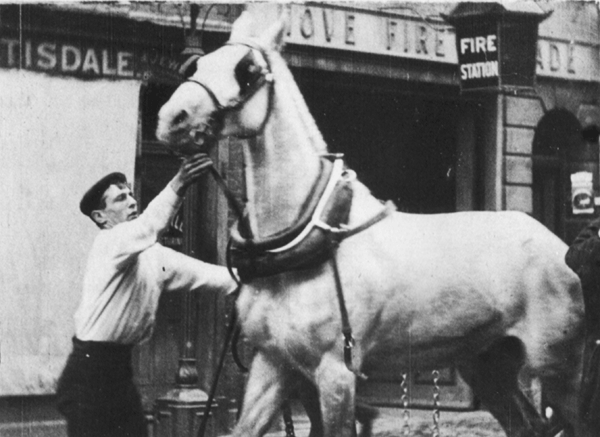  
Fire! (US title Life of a London Fireman) †* 280ft (October).
—narrative drama, featuring Hove Fire Brigade. A policeman finds a house on fire and rushes to the fire station, from which the horse-drawn fire-engines race off. In the house a man (John Cobbold) gets out of bed to try to extinguish the fire with a jug of water but collapses. A fireman smashes the window and carries the man down the ladder. Another fireman fetches a child out through the french window, while another person jumps from an upstairs window into a sheet. The five scenes included one outside Hove Fire Station, which was then at 85 George Street [above left]; the fire brigade races through the streets [above centre] (possibly St Aubyns); the fire itself was staged at the derelict Ivy Lodge [above right]. Released in the US by Vitagraph, 21
March 1903. View online.
Harlequinade: What They Found in the Laundry Basket (December) 240ft.
The Magic Extinguisher (US title The Magic Cone) † (October) 110ft.
—Sam Dalton as a conjurer who places an extinguisher over a dog, which changes into a cat, then over some kittens that turn into eggs, then into chicks. He places the extinguisher over his head and turns into a boy. Released in the US by Kleine, November 1905. View online.
Marvellous Capillary Elixir.
—Uncertain.
The Marvellous Hair Restorer (alt title: Magic Hair Restorer) 105ft.
—features Sam Dalton. Released in the US by Kleine, November 1905.
Over the Garden Wall Comedy, 65ft.
—Released in the US by Biograph and Kleine, 21 November 1903.
The Puzzled Bather and His Animated Clothes (alt titles: The Puzzled Bather, The Bather) (October) 80ft.
—‘A man on a river bank removes his jacket and cap, intending to take a swim, but as each item of clothing is removed it is immediately replaced by another. Exasperated, he dives in fully clothed, and pops out again wearing his bathing suit. However, the clothes he has left in the water follow him out one by one and he finds himself fully dressed again. He walks away resignedly, followed by the clothing he has left on the bank.’(National Film Archive catalogue description.) Released in the US by Kleine and Biograph, 28 November 1903.
Scenes on the Beach at Brighton 100ft.
—Filmed opposite Oriental Place. Girls playing handball, then running around bathing huts; people in the water as a rowing boat passes, splashing around and a view up the beach towards Bedford Square, View online.
  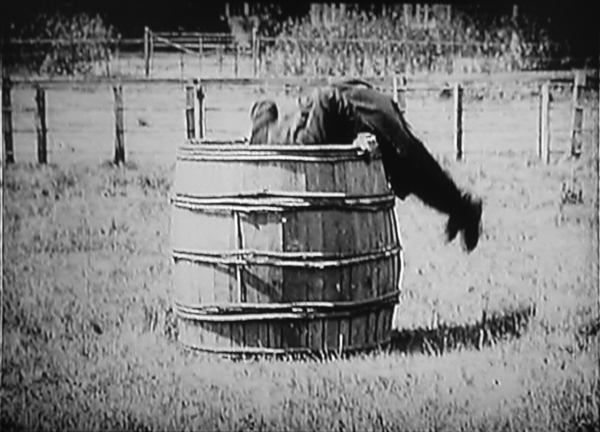
Stop Thief! † * 115ft (October)
—A three-shot chase—perhaps the first ever made—anticipating the Keystone Kops. Sam Dalton is a tramp who steals meat from the tray of a passing butcher's boy. The tramp hides in a barrel as dogs gather round and the butcher’s boy pulls him out. Released in the US by Biograph and Kleine, 28 November 1903. The second shot includes a deliberate jump-cut to speed up action, of the kind not normally practised until the French New Wave cinema of the late 1950s. [0067] View online.
Teasing Grandpa 92ft.
—Another in the 'two naughty boys' series, featuring Williamson's sons Alan and Colin.
Tomorrow Will be Friday 95ft.
—features John Macauley, a 'robust tenor' from the D'Oyly Carte Opera Company, who was appearing in the opening programme at the newly-opened Hippodrome on 26 August-21 September 1901.
¶ James Williamson away from Brighton:
Queen Victoria's Funeral series (January): The Alberta Leaving the Trinity Pier (60ft), Funeral of Her Late Majesty (100ft), The London Procession (170ft).
—This was the first news event to be seen around the world.
• 1902
¶ Laura Bayley for GAS Films:
Mother Goose Nursery Rhymes total: 550ft or 600ft.
—Eight separate semi-animated scenes and live action illustrating nursery rhymes, probably re-enacted from a pantomime, featuring Tom Green and probably directed by Laura Bayley and made with a Biokam 17.5 camera. Released in the US by Edison Manufacturing Company February 1903.
Goosey Gander.
Hey, Diddle Diddle, The Cat and the Fiddle. † 57 secs.
—View online.
Jack and Jill.
Little Miss Muffet.
Old King Cole and Blackbird Pie. †
Old Mother Hubbard. †
Old Woman in a Shoe.
Sing a Song of Sixpence
¶ G A Smith for GAS Films. Some of these appear to be re-releases of earlier films, possibly in 17.5mm Biokam versions.
After Dark, or The Policeman and His Lantern (US title Life of a London Policeman and Life of a London Bobby) 200ft or 225ft.
—Features Tom Green. 'This is a mixture of fun and pathos. When the picture first bursts into view, the exterior of an English Police Station is seen, from which the squad emerges. A change and then one of the "finest" is seen posing before a great building as though proud of his uniform. Again a change and we see a table on which was placed a dark lantern. Bobby's hand reaches forth and grasps the lantern and we follow him through the famous "White Chapel" district of which we have heard so much. All that is seen are the rays of light from the lantern and the object at which they are pointed. We see a high board fence on which a number of advertisements appear and the rays move along until "Bobby's" best girl is seen on the top of the steps leading into the basement of the house where she is employed. In her hand she holds dainty viands, which she knows Bobby delights in, and she beckons to him to follow. In this case you can draw your own conclusions. We follow the light through all the dark passages of the district until it enters a bank building and surprises a burglar at work on a safe. Suddenly Bobby appears behind the lantern, a scuffle ensues and the burglar is captured. This is undoubtedly one of the most novel moving pictures ever made.' [Lubin catalogue synopsis] Released in the US by S Lubin 18 July 1903.
The Amazons' March and Evolutions(alt title The March of the Amazons) 75ft.
At Last! That Awful Tooth (alt title Oh! That Awful Tooth) 50ft.
Baby in a Pram.
The Cakewalk 75ft.
—features The Melrose Trio (includes Mat and Lalla Melrose), music hall artistes who were appearing at the Hippodrome in the week of 7-12 July 1902; the cakewalk dance was part of their act. Released in the US by Kleine, November 1905.
The Comedian and the Flypaper (US title The Absent Minded Clerk, Fly Paper and Silk Hat) 75ft.
—features Mat Melrose, a member of the music hall trio (see The Cakewalk. above); ‘The absent-minded clerk is about to leave the office on an errand. He reaches for his silk hat, which he had thoughtlessly placed on a piece of fly-paper lying on the table. As he is about to place the hat on his head, he finds it sticks to his hand. He then places the paper on the floor and tries to free himself from it by stepping upon it, but it sticks fast to his shoes. He then pulls it from his shoe, and it sticks fast to the other hand. An idea then seizes him and he places it upon the table and sits on it. Pulling it from his hand, he leaves the room in apparent satisfaction, but to the great laughter of the audience, the fly-paper is hanging to his coat tails’ (Edison catalogue). Released in the US by Edison Manufacturing Company May 1902.
The Donkey and the Serpentine Dancer 75ft.
An Episode in the Life of a Lodger 110ft.
Hilarity of Board Ship 125ft.
His First Cigar, Probably His Last (alt titles A Bad Cigar, That Awful Cigar) 100ft.
—Possibly the same as A Bad Cigar (1900), re-issued in a Biokam 17.5mm version.
How Pa Reads the Morning Paper.
The Irishman and His Button 50ft.
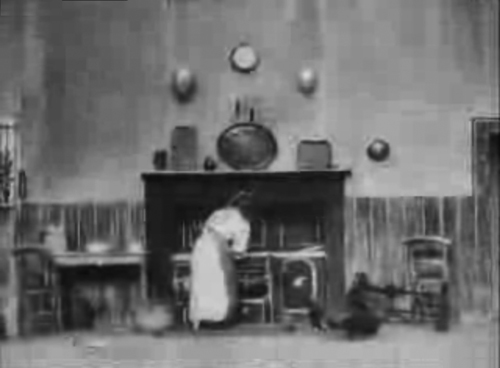  
 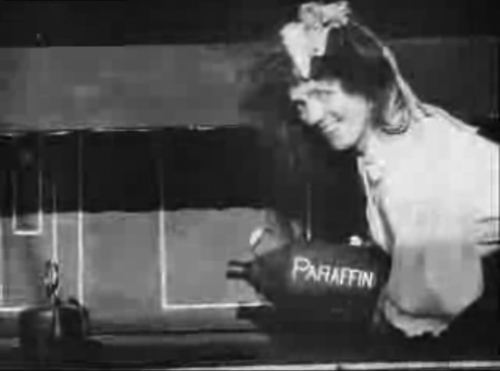 
 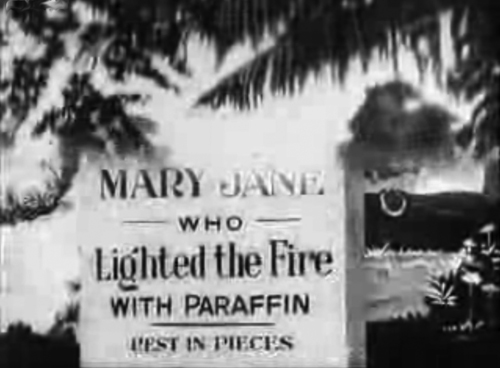 
Mary Jane's Mishap, or Don't Fool with the Paraffin †* 250ft
—The film consists of 14 shots. In the opening sequence of Mary Jane (Laura Bayley) entering the kitchen, building the fire in the range and blacking the boots, Smith used the innovation of cutting from the wider establishing shot to closer shots to direct the audience’s attention. In particular, he uses close-ups of Laura Bayley as Mary Jane playing to the camera when she admires her smudged face in a mirror and of her pouring paraffin on the fire in which she winks at the camera. This is an unusual and significant breaking of the ‘fourth-wall’ convention, drawing the audience into complicity with her actions. When the fire explodes and blows Mary Jane up the chimney, Smith uses a jump cut just as the cloud of smoke expands to take Mary Jane out of shot. She next appears (in life-size dummy form) emerging from the chimney and descending in pieces. The close-up of her tombstone, effectively an intertitle—complete with ‘Rest in Pieces’ joke—gives way to a graveyard scene through a vertical soft-edge wipe—both pioneering aspects of film grammar. Finally, the women who visit the grave are scared away by Mary Jane’s superimposed ghost. She reaches down the paraffin can and returns to the earth as her cat stands by the grave. A substantially extended reworking of Biograph’s How Brigit Made the Fire (1900) and a two-shot Edison film, The Finish of Bridget McKeen (1901), this shows the level of sophistication to which Smith’s filmmaking has aspired. Released in the US by Biograph, Kleine, Edison and S Lubin, April 1903. View online.
The March of the Amazons 75ft.
The Monk in the Monastery Wine Cellar 50ft.
—features D Philippe. Released in the US by American Mutoscope and Biograph Company April 1903.
The Monk in the Studio 100ft.
—features D Philippe.
The Monk's Macaroni Feast 125ft.
—features D Philippe.
The Monk's Ruse for Lunch 100ft.
—features D Philippe.
Old Lady Tries to Thread Her Needle † 45ft.
—Possibly the version of Grandma Threading Her Needle (1900) released in the US by Edison, September 1902. A 45ft copy with this title dated 1902 is in the National Film Archive.
Oh That Collar Button! 50ft.
Pa's Comment on the Morning News † 75ft
—A ‘facial’, showing Pa reading the paper, thumping the table and breaking his boiled egg, which smells bad. Released in the US by American Mutoscope and Biograph Company, April 1903. Also released in a 17.5mm Biokam version with the title How Pa Reads the Morning Paper.
Pantomime Girls Having a Lark 50ft.
—Possibly made to show during a stage performance.
Policeman and Burglar † (46ft).
—A policeman finds a burglar at work, they fight and the policeman makes an arrest. Probably a 17.5mm Biokam release of the last scene of After Dark [qv above].
The Puritan Maiden's Upside-Down Dance.
—Biokam version re-release of the 1900 film Topsy-Turvy Dance by Three Quaker Maidens [qv].
Robinson Crusoe †
Tambourine Dancing Quartet 135ft.
Tommy and the Mouse in the Art School (alt title Little Willie and the Mouse) 50ft.
Tommy Atkins and his Harriet on a Bank Holiday 50ft.
Too Much of a Good Thing 50ft.
The Two Old Sports at the Music Hall 75ft.
—The latest in the series featuring Tom Green and J D Hunter.
¶ G A Smith for Warwick Trading Company:
Ascent of a Crystal Palace Balloon 75ft.
Ping-Pong Contest at Crystal Palace 50ft.
Various Stages of Balloon Inflation 125ft.
¶ Georges Méliès and G A Smith, co-directed for Warwick Trading Company and Star Films:
 
Coronation of Their Majesties King Edward VII and Queen Alexandria [sic] (alt title Le Sacré d'Edouard) (June)
The big news event of 1902—apart from the end of the Boer War—was Edward VII’s coronation, the first such ceremonial since Queen Victoria’s in 1838 and the first since the advent of the cinematograph. The Mutoscope and Biograph company had secured the rights to film the actual event, So Charles Urban of Warwick Trading Company commissioned a version of the ceremony to be co-directed by George Albert Smith and Georges Méliès and made with actors in advance at Méliès' Star Films studio in Montreil, Paris.
The idea was to have the film ready for release at the time of the event on 26 June. However, the king fell ill and the coronation was postponed until 9 August. This still shows that the lavish production of The Coronation of Their Majesties King Edward VII and Queen Alexandria [sic] (alt title Le Sacré d’Edouard) would probably have outshone its actuality rivals, hinting at the enhanced production values that were to come. Already a film could cost $10,000 to produce (equivalent to £430,000 today), as the press advertising for the US release of the film announces.
¶ James Williamson for Williamson & Co/Williamson Kinematograph Company:
• This year Williamson builds his glasshouse STudio at Cambridge Grove
The Acrobatic Tramps 104ft.
—Trick comedy featuring John and Charles Cobbold (a possible precursor of Chaplin?) Released in the US June 1908.
An Amateur Bill Sykes 88ft.
—Comedy about a burglar.
Burlesque of Popular Composers 150ft.
—Popular music hall act featuring Ford and Hanson, ‘the American musical millionaires’.
Captain Clives and his Clever Dog Tiger
—features Captain Clives (real name Alfred Holmes), 'the World's Only Dog Equilibrist'.
Close Quarters, with a Notion of the Motion of the Ocean (alt title: Down Below) (July) 115ft.
—Comedy. Released in the US by Biograph and Kleine, 21 November 1903.
A Day in Camp with the Volunteers (July) 200ft.
—Observational comedy in seven scenes. Reveille
and morning activities in a military camp
An Extra Turn 70ft.
—Comedy
Fighting His Battles Over Again 145ft.
—A Chelsea pensioner joins a group of young soldiers in conversation, showing how he would have used a fixed bayonet but the effort reminds him of his age. He is heartily cheered by his audience.
A Lady's First Lesson on the Bicycle 75ft
—features Nellie Wallace and John Cobbold. Nellie Wallace (1870-1948) was one of the enduring stars of music hall. She appeared at the Palace Pier theatre and at the Hippodrome and was at the Empire in the week of 21 April 1902.
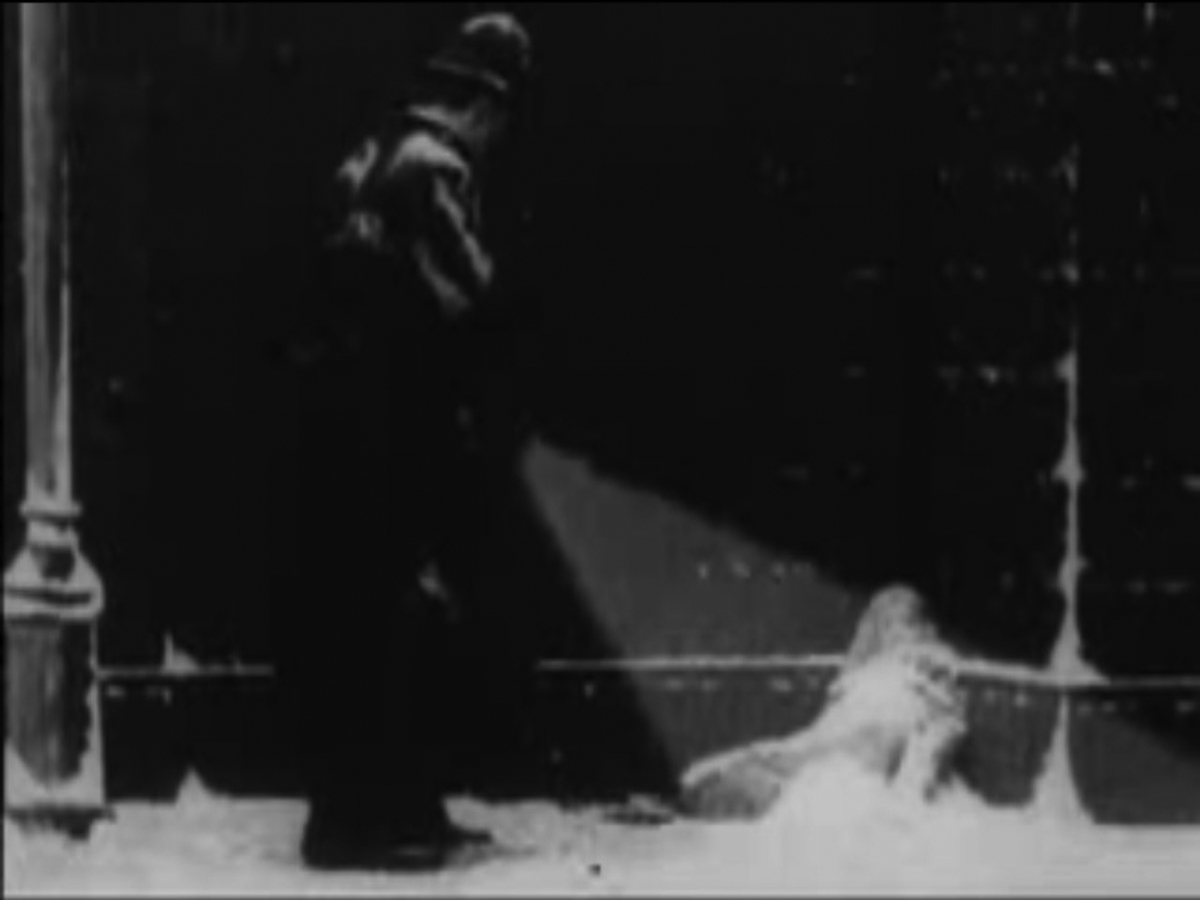 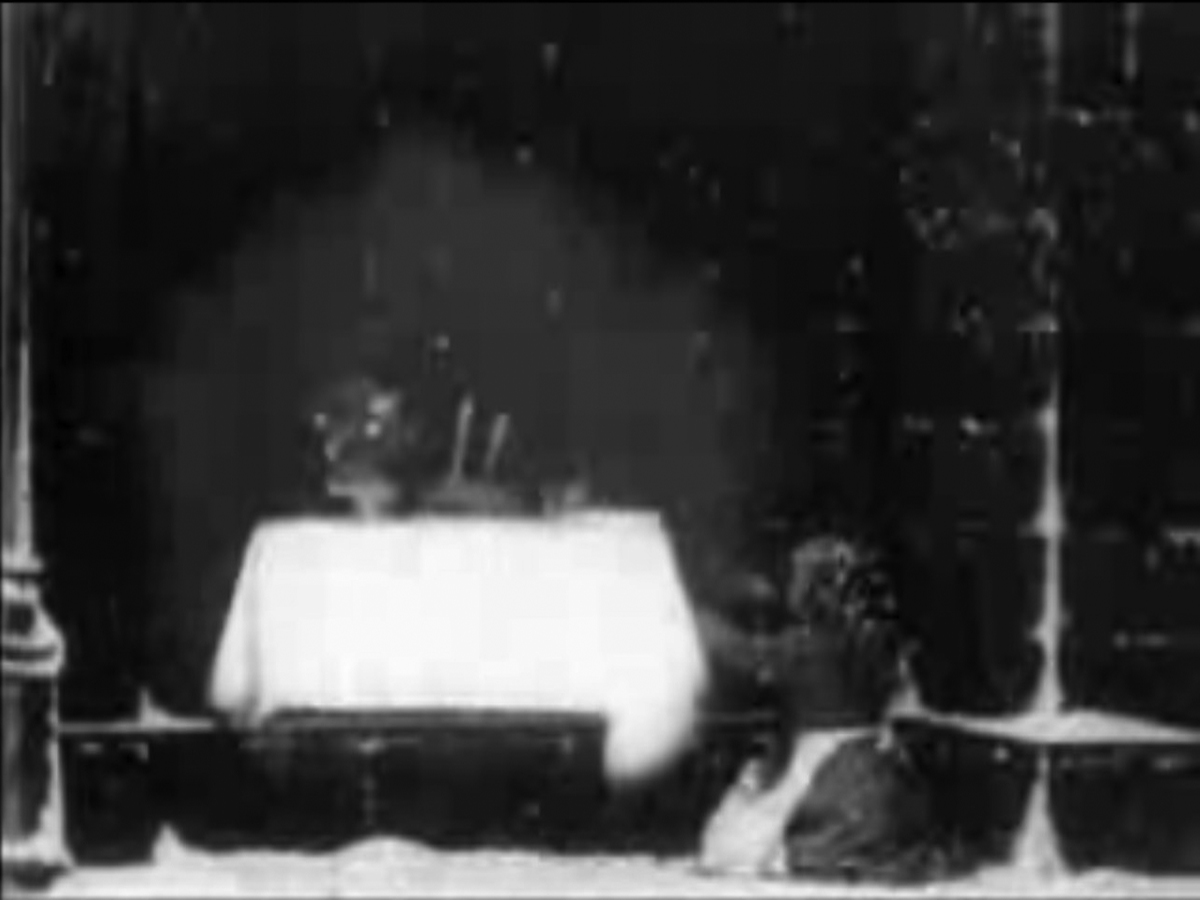 
The Little Match Seller (alt title: The Little Match Girl) † 210ft
—This is one of the earliest film adaptations from a literary source, the story by Hans Christian Andersen. In a snowy street, a girl seeks help from a passing gentleman, is attacked with a snowball by a boy, is ignored by the lamplighter. She strikes a match on the wall and the light of the match causes the wall to be transparent and the room behind to become visible. She strikes a second, third and fourth match, then expires. An angel lifts the girl's spirit to heaven. A policeman finds her body. Williamson shows considerable skill in aligning the double exposures, especially of the plate of food, which appears to move into the girl’s hands (the figure of a child moving the plate can be detected faintly in some frames), and the policeman's lantern beam is also superimposed. The continuing fall of snow is impressive. This may be the first time a ghostly spirit is seen on film leaving a more corporeal dead body in the final double exposure of the girl being carried aloft by an angel. The girl and boy are probably Lilian and Tom Williamson. Released in the US by Edison, 21 March 1903. View online.
No Bathing Allowed 140ft
—Comedy, featuring Charles Cobbold. A man, missing a sign, goes swimming in the river. When warned by passing rowers he climbs out but as he is drying himself his fiancée and her mother approach. They stop to inspect a statue. The swimmer in panic drapes himself in a towel and poses on a vacant pedestal. His fiancée prods him with her umbrella and he is discovered. Released in the US by Edison, 25 April 1904.
 Ping-Pong (US title The Hodcarriers' Ping Pong) 90ft.
Ping-Pong (US title The Hodcarriers' Ping Pong) 90ft.
—‘Two hodcarriers are seated upon a large lime barrel eating their lunch. Having finished their lunches and lighted their pipes, they propose a game of ping pong. An old door is laid across the barrel, and a piece of joist laid crosswise on the door to take the place of a net. A rubber ball is produced and the sons of Erin each produce a trowel, and the game begins. As is almost always the case when Paddy and Mike engage in sport, a dispute ensues. Mike endeavors to explain the rules of the game to Paddy, but Paddy won't have it, and biff; the fight begins. Paddy and Mike fall into the mortar, and when the fight is stopped by the arrival of the boss, they are simply “sights”. ’ (Catalogue entry.) Released in the US by Edison, September 1902.
Plumpton Steeplechase 2 parts totally 220ft.
—At the racecourse north of Brighton.
Professor Reddish Performs his Celebrated Bicycle Dive † 80ft
—a trick cyclist, 'Professor' Reddish, rides down a ramp and dives off the West Pier on his bicycle, seen also in reverse [right]. According to the BFI's screenonline, a longer version of the film with the title Flying the Foam and Some Fancy Diving was issued in 1906. However, as the difference in length is 40ft (ie, less than three seconds), that may be accounted for simply by the addition of a title.
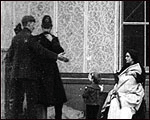 
A Reservist Before the War and After the War (December) † 290ft. [above left]
—Social realism, with intertitling. A man at home with his family receives his call-up. On his return he finds the home bare and steals bread from a baker’s cart. A policeman follows him home, discovers his circumstances and takes pity.
Sambo 80ft
—features Sam Dalton in blackface, smoking a cigar. Released in the US by Kleine, November 1905.
The Soldier's Return (June) † 185ft. [above right]
—Social realism: ‘A soldier, returning from the [Boer] war, finds his humble cottage empty and desolate. Neighbors and friends crowd around him and inform him that his aged mother has gone to the poor house. He immediately hastens thither and a touching scene occurs at their meeting. The mother's departure from the institution leaning on her stalwart son's arm, and her farewell to the old women inmates, is affectionate in the extreme. Home again, the mother sits contented in the doorway while her soldier boy works busily in the little garden. A beautiful story told in a man ner that appeals directly to the heart.’ (Edison catalogue). ‘This is a complete story without words and we do not hesitate in saying that no matter where it is shown, it will appeal to old and young alike and will move any audience to tears. No expense has been spared to make this film perfect in every respect.’ (Lubin catalogue). Partly filmed at the Brighton Workhouse in Elm Grove (now Brighton General Hospital). Released in the US by Biograph, Edison, Kleine, Lubin and Vitagraph, January 1903.
Those Troublesome Boys (july) 102 ft.
—Features Williamson’s sons Alan and Colin in a continuation of the ‘two naughty boys’ series that started in 1898. ‘A workingman is busy mixing cement in a door yard. Two small boys are watching the proceedings interestedly but are driven away by the workingman. They decide to get even with him and during an interim, while he is called away, they arrange a bucket of mortar on the end of a plank in such a manner that when the workingman returns and com mences to pound the foundation of the walk he strikes the end of the plank and the pail of mortar flies in the air and the contents completely covers him much to the glee of the two youngsters.’ (Biograph catalogue) Released in the US by Biograph and Kleine, February 1904.
A Workman's Paradise (june) 170ft.
—Extensive use of reversed film. ‘Scene, a building in course of construction. Hodcarrier arrives, and placing the hod in an upright position, he turns his attention to a load of bricks nearby. Wishing to fill the hod and being too lazy to stoop for bricks, he commands them to come to him. Suddenly the bricks are seen to rise from the ground and jump into his hands. One by one they are placed in the hod, until it is filled. His commands thus far having been obeyed, he tries it again on the hod. Walking away from it, he beckons it to follow him, and instantly it begins to move. Scene now changes to the scaffold. The hodcarrier jumps to it from the ground, and is followed by the hod and bricks. After emptying the hod, he goes for mortar and this is secured in the same way as the bricks. After putting the mortar on the board used for holding it, the hodcarrier leaves the scene. Upon seeing the success met by the hodcarrier, the bricklayer, who has been working on the scaffold, tries his hand with the magical bricks and mortar. He commands them to come to him. They rise from where they were placed by the hodcarrier, and adjust themselves in place on the building. A very amusing subject and sure to cause a laugh.’ (Edison catalogue) Released in the US by Edison, Kleine and Vitagraph, 21 March 1903.
¶ James Williamson away from Brighton:
Coronation Procession series: Close View of State Coach (20ft), Dress Carriages (50ft), The King's Procession (100ft), Prince of Wales's Procession (45ft), The State Coach (120ft), The State Coach at the Canadian Arch (40ft), Trumpeters Royal Horse Guards (45ft).
—Filmed on postponed date of 9 August (see box above).
Coronation Through London on Wednesday June 25 nine parts totalling 346ft.
—This must have been a rehearsal as the coronation, scheduled for 26 June, was postponed on 24 June because the king required an emergency appendectomy. The coronation took place on 9 August.
The Imperial Troupe of Russian Dancers.
Magnificent Panorama of the Fleet three parts, totalling 487ft.
Naval Review 125ft.
Opening of Parliament Procession.
Panorama on the Belfast and North of Ireland Railway. 250ft
Scotland series: Circular Panorama of Edinburgh (60ft), Circular Panorama of the Forth Bridge (65ft), Panorama of Princes Street, Edinburgh (90ft), Ride on the Glasgow Trams (130ft), Scenes on the Clyde (75ft).
• 1903
¶ Hepworth Manufacturing Company:
At Brighton Beach 100ft.
—‘This is a very humorous series of views at England's great popular seaside resort and is full of laughable incidents. The fakirs are shown at work and various seaside amusements depicted, among them a group of costerwomen and children wading. The whole scene is excellent throughout, very sharp and clear photographically.’ (Biograph catalogue) Released in theUS by Kleine and Biograph, September 1903.
¶ G A Smith for GAS Films, distributed in the UK by Urban Trading Company:
The Baby and the Ape (US title The Baby, the Monkey and the Milk Bottle) 150ft.
—Released in the US by Georges Méliès January 1904.
Dorothy's Dream (alt title A Dream of Fairyland) 570ft, 573ft or 600ft
—features Eva Bayley. Dorothy (presaging The Wizard of Oz?) dreams of being a series of characters: Aladdin, Bluebeard, Cinderella, Dick Whittington. Released in the US by Kleine Optical Company/Edison Manufacturing Company July 1904.
The Free Trade Bench 50ft.
—An early political film. Smith was apparently a supporter of the more protectionist 'fair trade' proposition of Joseph Chamberlain, the Secretary of State for the Colonies.
John Bull's Hearth (alt title John Bull's Fireside) 185ft
—A rare piece of political polemic, concerning a debate then under way between advocates of free trade and those, led by Joseph Chamberlain MP, who argued for fair trade. The Optical Lantern and Cinematographic Journal described it thus: A 'Frenchman and German, Russian and American ... enter singly, and, seeing the words "Free Trade" over the mantlepiece, seat themselves comfortably round John's fire, leaving him standing room only. While in this position a Colonial arrives, and with the help of John, turns out the foreigners.' The Colonial shows the audience a picture of Joseph Chamberlain and replaces the 'Free Trade' sign with one proclaimsing 'Fair Trade'. Released by Urban Trading Company. Two versions exist with variations in costumes, a scroll rather than a sign and three colonials rather than one.
 The Little Witness.
The Little Witness.
The Sick Kitten †* 1 min
—A remake of his 1901 film The Little Doctors. The girl holds the kitten as a second cat looks in. The boy in a top hat enters as the doctor, goes to fetch a jar of fish juice, which the girl spoons into the kitten's mouth in close-up. The boy and girl shake hands, he raises is hat to the camera and exits. View online.
¶ G A Smith away from Brighton for Charles Urban Trading Company:
The Girl on the Ball (27 June).
—Newsreel footage of Mlle Florence, an American music hall artiste, as she approaches Brighton on a walk in six days from London to Brighton balancing on a large rubber ball, approximately two feet in diameter. The film is shown the same night at the Alhambra and Hippodrome. Released in the US by Biograph, September 1903 and by Kleine in 1905.
¶ James Williamson for Williamson Kinematograph Company:
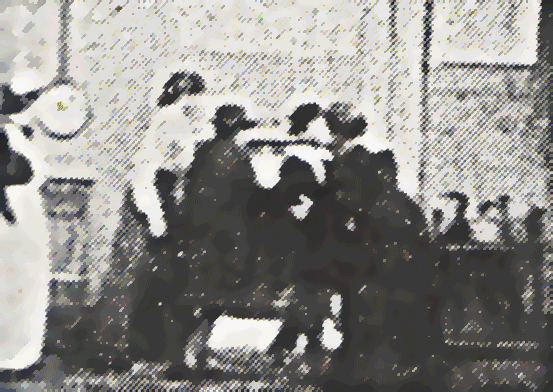 The Dear Boys Home for the Holidays (alt title: Boys Will be Boys) † (December) 290ft. [right] The Dear Boys Home for the Holidays (alt title: Boys Will be Boys) † (December) 290ft. [right]
—Two boys are welcomed home by their mother but then get up to pranks. Williamson appears as the father, his sons Tom and Stuart play the boys, who mess around, paint a moustache and beard on the baby's face. Their father catches them and when they come back into the room they remove cardboard from their trousers. Released in the US by Edison, 25 April 1904. Re-released by Williamson & Co, 8 February 1908.View online.
The Deserter (October) 520ft.
—Melodrama in eight scenes in which a soldier must desert to attend his father's deathbed. Released in the US by Edison, Biograph and Kleine, 21 November 1903.
The Evil-doer's Sad End (November) 125ft.
—Trick film. Released in the US by Edison, 25 April 1904.
Juggins' Motor (December) 125ft.
—Comedy.
Quarrelsome Neighbours (June) 125ft.
—Comedy. Released in the US by Biograph, Edison and Kleine, 21 November 1903.
Remorse: A tragedy in five acts (June) 450 ft.
—features D Philippe in a five-scene version of his own play. Released in the US by Williamson & Co, 14 March 1908.
Spring Cleaning 210ft.
—Five scenes. ‘One of the greatest comedy films ever taken; illustrative of a topical event and thoroughly up to date. It consists of a series of humorous catastrophes following each other in such rapid succession that at the finish of the subject the audience is left convulsed with laughter. Like the celebrated character of Mrs Macstinger, in Dickens' Dombey & Son, the lady of the house is evidently in the throes of spring cleaning. Her husband wanders disconsolately from room to room, trying to find one spare corner, where he can write a letter in peace. His adventures with the domestics, painters, paperhangers, chimney sweep and other assistants inthe art of housecleaning, while looking for a secluded spot, constitute the whole story. The subject is clear throughout, photographically perfect, and the humor is such, that we can safely predict it will be a winner wherever shown.’ (Edison catalogue). Williamson appears as the father. Released in the US by Biograph, Edison and Kleine, 16 May 1903.
A Trip to Southend or Blackpool (July) 163ft.
—Comedy. Released in the US by Biograph and Kleine, 21 November 1903.
Wait Till Jack Comes Home (September) 430ft.
—Drama in seven scenes. Released in the US by Biograph and Kleine, 28 November 1903. Re-released as When Our Sailor Son Comes Home (465ft) by Williamson & Co on 21 March 1908.
The Workman's Paradise. 170ft.
—Trick film of bricks and mortar laying themselves.
The Wrong Chimney 150ft. Uncertain
The Wrong Poison (July) 160ft.
—A ‘facial’ about the demon drink. Released in the US by Edison and Kleine, 25 April 1904.
¶ Benjamin Jumeaux and W Lascelles Davidson:
The Rival Clothiers †
—The first trichrome test film, made on an 82mm strip with three images side by side to be merged by projecting through red, green and blue filters, shot in Brighton or Southwick. View online.
• 1904
¶ Alf Collins for Société des Etablissements L Gaumont
On Brighton Pier
A Day at Brighton (US title At Brighton)
—‘A Coster family are eating their luncheon on the sand [sic], and are interrupted by various peddlers, until finally they begin to get into a quarrel with the Hokey-Pokey man who is attacked by the entire crowd and his wares scattered over the beach. The family then decide to go for a sail; they are first shown embarking on a small fishing schooner, then after ward at sea pitching and tossing in a heavy swell. This scene is particularly effective and very amusing, because the entire family are seasick, and to all appearance their seasickness is genuine. The finish of the picture shows their arrival on shore where they are carried out of the boat, most of them in a state of collapse.’(Biograph catalogue) Released in the US by Kleine and Biograph, December 1904.
¶ G A Smith for GAS Films, distributed by Charles Urban Trading Company:
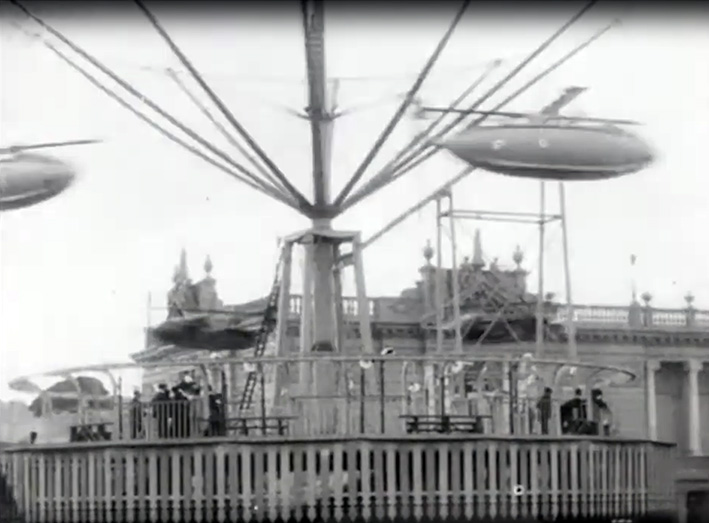 Holiday Makers Dancing on Crystal Palace Terrace 50ft.
Holiday Makers Dancing on Crystal Palace Terrace 50ft.
International Cycling Races at Crystal Palace 225ft.
Motor Climbing Contest at Crystal Palace 125ft.
Phillips' New Flying Machine 100ft.
Repulsing an Attack by Artillery and Cycle Maxim Corps 175ft.
Sir Hiram Maxim's Captive Flying Machines 75ft. [right]
—A fairground roundabout at Crystal Palace of suspended flying machines. View online.
• Smith now ceases regular film production to concentrate on development of colour cinematography, for which he shoots experiments:
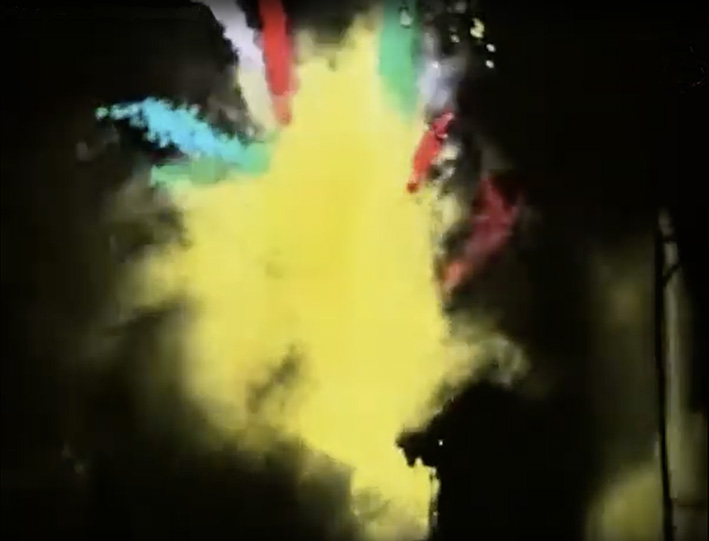 Fireworks Display at Crystal Palace † 125ft.
Fireworks Display at Crystal Palace † 125ft.
Great Display of Brock's Fireworks at the Crystal Palace 275ft. [right]
—View online.
¶ James Williamson for Williamson Kinematograph Company:
An Affair of Honour (December) 210ft.
—‘Two Frenchmen quarrel over a newspaper in a café and exchange cards. They meet in the morning and several shots are exchanged, but they are uninjured. Not so the poor doctor and seconds;they are either dead or wounded. Then the combatants, fearing doubtless they may get injured, decide that honour is satisfied and leave the field good friends.’ (Butcher’s catalogue). Released in the US by Williamson & Co and Edison, August 1905.
All's Well that Ends Well (October)
—Comedy, distributed by Urban Trading Company
The Clown's Telegram (August) 255ft.
—A pathetic drama.
 Gabriel Grub the Surly Sexton (US title Gabriel Grub) 445ft (8 mins).
Gabriel Grub the Surly Sexton (US title Gabriel Grub) 445ft (8 mins).
—From a story by Charles Dickens and based on a set of lantern slides, distributed by Urban Trading Company.Released in the US by Williamson & Co, 8 February 1908. A version of the optical lantern show is available on a BFI DVD.
The Great Sea Serpent (July) 135ft. [right]
—Comedy. ‘Mr MacDoodle, in true nautical attire, goes for a tripon a steamer and is “had” by his friends with the aid of a centipede and his telescope, when the harmless inset becomes a monster of the deep.’ (Butcher’s catalogue). Released in the US by Edison, December 1904.
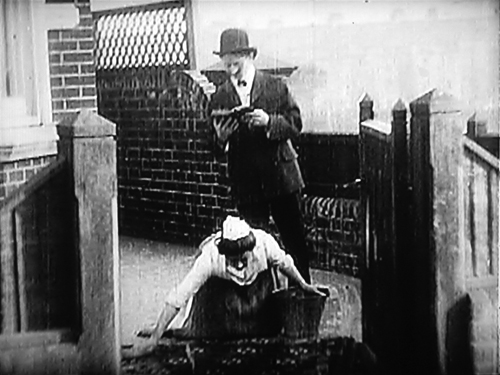  
An Interesting Story †* (October) 235ft.
—Comedy in six scenes. A man has his nose in a book. He pours coffee into his hat rather than his cup. He trips over thewoman cleaning his front step and wanders off down the road, surviving various mishaps. Partly filmed in the Williamson studio grounds: two girls skip in front of Rose Cottage, the family home, between the glasshouse studio and terraced houses at the rear of Cambridge Grove (then Cambridge Stables). He meets a donkey at the end of Cambridge Grove. In the final sequence, which appears to have beenfilmed in the vicinity of Southlands Hospital at Southwick, he is flattened by a steamroller but revived by two passing cyclists who use their pumps to reinflate him. The absentminded reader walks off in a manner reminiscent of the Chaplin walk of a decade later. [A similar character, Dr Greenbow, appears in Alfred Hitchcock's black comedy The Trouble with Harry but without the steamroller.] Charles Urban catalogue number 4266 (June 1905); Released in the US by Edison, December 1904. View online.
Oh! What a Surprise! (July) 90ft
—Comedy. ‘What mischief makers boys are, ... how two bags of flour become two flower girls, and in what a difficult position they placed a poor man blessed with a jealous wife.’ (Butcher’s catalogue). Features Williamson’s sons Tom and Stuart. Distributed in the US by Edison, December 1904.
The Old Chorister † 235ft.
—An old man hears distant singing in a park. He remembers singing in the choir in his youth. At the church the vicar calls in fighting choir boys and invites the old man in. As he sings he sees an angel and dies at the altar. Intended to be used with live performance of C H Roberts’ song, The Aged Chorister, following the instructions in Williamson’s catalogue: ‘At the point where the Old Chorister is remembering his younger days, an on-site boy soprano is to sing the opening measures of Handel’s I know that my Redeemer liveth and again during the scene where the choir is singing in the church, an on-site chorus sings a verse of Sir Arthur Sullivan’s Onward Christian Soldiers, breaking off at the point where the old man is stricken.’ How often such forces were assembled is not recorded.
The Stowaway (September) 550ft.
—Temperance drama in nine scenes, featuring Marie Mayhew.
The Student and the Housemaid (August) 135ft.
They Forgot the Gamekeeper (July) 65ft.
The Tramp's Revenge (December) 210ft.
—‘A tramp is rather roughly handled by a policeman and naturally looks round for a chance of revenge. This chance is soon offered by the policeman leaving his coat and helmet outside a house where he is entertained by the cook. The tramp makes excellent use of these on a country road, where he extracts a tip from a scorching motorist. He then sends the policeman on a fool’s errand on being asked concerning the lost property and feels amply revenged.’ (Butcher’s catalogue).
Two Brave Little Japs (September) 490ft.
—War melodrama.
• 1905
¶ James Williamson for Williamson Kinematograph Company:
Brown's Half Holiday 400ft.
—distributed by Urban Trading Company
An Eclipse of the Moon 170ft.
—distributed by Urban Trading Company
In the Good Old Times 55ft.
—distributed by Urban Trading Company

Our New Errand Boy † (August) 350ft.
—Williamson appears as the grocer, his son Tom as the errand boy, who gets up to tricks that culminate in his being chased by a group of adults. The film runs for nearly six minutes and, although there are only 12 shots, the narrative has pace and style. Williamson mixes types of composition: the shop (Hodder’s at 2 Lorna Road—now numbered 99) is filmed square on with people arriving from various angles. The scene of the two boys crossing the railway bridge has the rest of Wilbury Villas in the background and the water cart scene also shows the road stretching beyond. Three scenes make use of the corners of buildings to show people approaching from two angles. Released in the US by Williamson & Co, 14 March 1908. Many scenes in Williamson's films can clearly be located in still identifiable parts of the area where he worked, giving them an added interest. View online.
The Polite Lunatic (September) 100ft.
—Chase film. A plumber drops his putty knife, then runs away from a passer-by who tries to hand it back to him. Distributed by Urban Trading Company. View online.
The Prodigal Son, or Ruined at the Races (August) 585ft.
—Williamson’s longest film to date, in 10 scenes and running for almost 10 minutes. ‘An excellent picture story, well told, in natural scenery, with good racecourse scene.'
The Real Sea Serpent. Uncertain.
Rival Barbers (July) 125ft.
—‘Barber No 1 displays a striking advertisement which Barber No 2 adds to, to the detriment of Barber No 1. Some boys and a gent see the joke, but not Barber No 1, who, thinking he has caught the delinquent, hands the gent into his shop, lathers him and kicks him out again to the amusement of Barber No 2, who commiserates with his rival.’ (Butcher’s catalogue). Released in the US by Williamson & Co, 15 February 1908.
Sausages (July) 275ft.
—‘A loafer is given a job of carrying round the streets a board with the following legend: “Above is what Chopper’s Sausages are made from”, above being a picture of a fine prize pig. But the man soon tires of his job,and is enticed to enter a public house with an acquaintance, leaving his boards outside. On resuming his boards he fails to notice that some bill-posters had changed the pig for a cat. The fame of this novel advertisement finally reaches Chopper, who chases his sandwich man, and a lively tussle takes place in the street, to the amusement of a large crowd.’ (Butcher’s catalogue).
The Two Little Waifs † (October) 481ft.
—A little boy stands outside Woodland Cottage. A gypsy caravan pulls up and a man grabs the boy and departs. The butler finds the boy's hat by the gate and calls the mother, who be comes distressed. The father and the butler go in search of the boy. At the gypsy camp the boy is ill-treated. A little gypsy girl brings food and consoles the boy. Later that night the two children escape along a country road and are given a ride on a cart. They alight near the boy's house. He runs inside, leaving the girl outside. The gardener chases the girl away. She begins to cry but the gypsy appears and takes the girl away. The father and boy drive off into their carriage to a gypsy encampment and are directed to a house. The old lady who answers the door has no knowledge of the girl but the boy, however, sees the girl waving from an upstairs window. The gypsy sees her waving and beats her. The gypsy fights with his wife, upsetting the stove and starting a fire. The father bangs on the outer door and is let into the now smoke-filled house. He rushes into the room and carries the girl down the burning stairs. The mother and father say they will adopt the girl, much to the boy's delight. (Adapted from National Film Archive description.) Two slightly different copies exist. Released in the US by Edison and Williamson & Co, January 1906.
• 1906
¶ G A Smith:
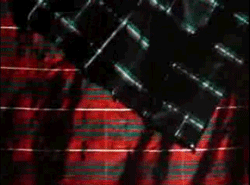 
Tartans of the Scottish Clans † (23 May) 100ft. [above left]
—Colour test film: a series of Scottish tartans slide away revealing the next. View online.
Two Clowns. † [above right]
—One male and one female clown joke together in a colour test film that bears a strong resemblance to Let Me Dream Again (1900). View online.
¶ G A Smith for Charles Urban Trading Company:
The Final Cup Tie Match (21 April) 400ft.
—Played at Crystal Palace. Result: Everton 1 Newcastle United 0.
Great Rugby Match: England v Springboks 300ft.
Togo's Heroes at the Crystal Palace 100ft.
¶ James Williamson for Williamson Kinematograph Company, all distributed by Urban Trading Company:
The Angler's Dream (May) 300ft.
A Day on His Own (August) 330ft.
—A man taking two girls to a fun fair is followed by his wife. Released in the US by Williams, Brown & Earle, 12 October 1907.
Flying the Foam and Some Fancy Diving (December) 95ft.
—This is a re-released version of Professor Reddish performs his Celebrated Bicycle Dive (see 1902), re-edited for comic effect. View online.Her First Cake 300ft.
Her First Cake † (May), 309ft).
—A new wife’s first attempt at cake-making is dropped on the head of a passer-by, rejected by a tramp and finally used in building a wall. A copy is in the National Film and Sound Archive, Australia.
The Miner’s Daughter † (August), 586ft.
—Romantic drama in 16 scenes. An artist asks if he can marry a miner’s daughter but is refused, so the couple elope and they establish a successful home. Years later the miner is injured in an under ground explosion (two red-tinted frames) but refuses his daughter’s visit to the hospital. The granddaughter finally brings the miner, his daughter and the artist together.
Mrs Brown Goes Home to Her Mother 350ft.
—Comedy.
The Sham Sword Swallower (July) 350ft.
—Two tramps are chased by a policeman and the crowd who have been watching their fake show. Released in the US by Williams, Brown & Earle, 12 October 1907.
Where There's a Will There's a Way (September) 675ft.
—Comedy in 18 scenes. A man elopes with girl by disguising himself as a gardener. Another man plays the piano and looks at a photograph of his sweetheart. He reads the newspaper classified ads and notices a vacancy for a gardener at his sweetheart's house. Disguised as a gardener, he is given a key by his employer for the gate. While he mows the lawn he gets closer to a woman sitting in a chair. He reveals that he is not the gardener by raising his beard and gives her the key for the gate. He motions his employer into the green house and locks him in. Outside the gate, relieved of his disguise, the man arrives in a chauffeur-driven car and helps the woman with her bag into the car. They drive off but another gardener, who has seen what happened releases the employer and they give chase in his chauffeur-driven car. The happy couple, notrealising they are being chased, stop outside an inn, change hats and set off for the church. The chauffeurtells the innkeeper what has happened and they disguise two sacks with the couple's hats and coats. The chauffeur drives off. The father, having been held up at a level crossing, is told at the inn that the couple have driven off. The father catches up but discovers that the couple are merely sacks. At the church the couple, now married, leave with the vicar. At the inn they find the car missing but the innkeeper explains. In the bar the couple are disturbed by the angry father. He calms down and accepts the marriage, giving them his blessing and toasting them in champagne.’ (adapted from National Film Archive catalogue description).
A Wicked Bounder (September) 550ft.
• 1907
¶ G A Smith for Charles Urban Trading Company:
The Great Football Cup Final 450ft.
—The FA Cup, played at Crystal Palace on 20 April, when The Wednesday beat Everton 2-1.
¶ James Williamson for Williamson Kinematograph Company:
After the Fancy Dress Ball (July) 6 mins/360ft.
—Comedy. Distributed by Gaumont and released in the US 7 September 1907 by Kleine Optical Company.
Bobby's Birthday (July) 212ft.
—Comedy. Released in the US by Williamson & Co, 15 February 1908.
The Brigand's Daughter
—Released in Europe by Urban-Eclipse and in the US 8 August 1908 by Kleine Optical Company on 8 August 1908.
Brown Goes to Mother 5½ mins/347ft.
—Distributed by Gaumont; released in the US February 1907 by Kleine Optical Company.
Cheating the Sweep. (January)
—Comedy; distributed by Gaumont.
Getting Rid of His Dog (October) 310ft.
—Comedy; released in the US by Williamson & Co, 4 April 1908.
Just in Time (August) 540ft.
—Adventure story. Released in the US by Williams, Brown & Earle, 19 October 1907.
Moving Day (September) 315ft.
The Orange Peel (May) 245ft/260ft.
—Features Tom Williamson. Distributed by Gaumont; released in the US 29 June 1907 by Kleine Optical Company.
The Orphans (November) 655ft.
—Pathetic drama. Released in the US by Williamson & Co, 4 April 1908.
Pa Takes Up Physical Culture. (US title: Poor Pa’s Folly). (August), 305ft.
—Comedy. Released in the US by Williamson & Co, 25 January 1908.
The Village Fire Brigade (January) 325ft.
—Drama. Distributed by Gaumont.
Why the Wedding Was Put Off (August) 225ft.
—Comedy. Released in US by Williamson & Co, 25
January 1908.
• 1908
¶ G A Smith for GAS Films and Charles Urban Trading Company in 'Kinemacolor':
Cat Studies † colour test film
Woman Draped in Patterned Handkerchiefs † colour test film, 45 seconds.
—Colour test film, probably filmed outside Laboratory Lodge, Roman Crescent, Southwick. The ‘handkerchiefs’ appear to be the same pieces of fabric used in the test film of tartans (1906).
A Visit to the Seaside (US title A Visit to the Seaside at Brighton Beach, England) † 517ft/1,035ft
—The first film made in Kinemacolor (trade shown September 1908) and almost certainly the world's first completed colour film. It features scenes of Brighton, including the White Coons and the Cameron Highlanders Band. The reason for there being two film lengths is probably that Kinemacolor used twice as much film, suggesting that the shorter version (half the length) was a monochrome copy for use in cinemas not equipped to show Kinemacolor. Moreover, one version was released by GAS Films and Charles Urban Trading Company, the other by Natural Colour Kinematograph Company. Released in the US by Kinemacolor Co. of America in December 1910.
Incident on Brighton Beach.
Sailing and Motor Boat Scenes at Southwick (alt title: Motor Boats and Yacht Races) 460ft.
View of the Brighton Seafront
• (Probably) not shot in Brighton for Kinemacolor:
Animal and Bird Studies 1,275ft.
Band of the Queen's Highlanders.
British Soldiers compilation totalling 840ft.
Church Parade of the 7th Hussars and 16th Lancers.
A Detachment of Gordon Highlanders.
The Letter.
The Rabbits, Sheep, A Carrot for the Donkey (alt title: Farmyard Friends) 1,155ft.
Reaping (alt title: The Harvest) 740ft.
Review of the British Navy 335ft.
The Soldier's Pet.
Swans.
A Visit to Aldershot.
¶ James Williamson for Williamson Kinematograph Company. Some may not have been directed by Williamson himself (known to be his are marked #), although there is scant information about who may have been the director.
The Ayah's Revenge. (September) 555ft ot 660ft.
—Crime story set in the India of the Raj: an Indian nurse steals an officer’s baby after she is sacked. The mother catches and shoots the nurse. Features Florence Williamson. Released in the US by Film Import and Trading Company, 2 October 1908.
A Countryman's Day in Town. (December) 350ft.
—Comedy.
A Day's Holiday. (February) 495ft.
—Comedy.
# The Great Bargain Sale.
—Comedy.
The £100 Reward † (April) 6 mins.
—Thieves break into a dressing table, steal jewels that they hide in a drain while making their getaway. A poor man returns home from work to be shown an empty cupboard by his wife. He takes the dog out with the intention of selling it. An elderly gentleman pays for the dog but the man changes his mind. The dog finds the jewels, which the man returns to their lady owner, who gives his the reward. Near the drain, the police nab the thieves. Back at his cottage, the man and his wife are visted by the lady and her maid, who give his dog a new collar. Released in the US by Williamson & Co, 11 April 1908. View online.
# The Little Mother. (September) 620ft.
—Drama.
My Wife's Dog. (August) 373ft.
—Man tries to catch the wrong Dalmatian. Released in the US by Film Import and Trading Co, 3 October 1908.
The Professor's Great Discovery. (April) 350ft.
—Comedy.
# The Reconciliation. (October) 360ft.
—Pathetic drama. ‘A squire's disowned son is shot while poaching to feed his starving wife’ (IMDb).
# The Rent Collector. (December) 360ft.
—Comedy.
The Rival Cyclists. † (March) 246ft but incomplete.
—This is the National Film Archive catalogue description. ‘A young lady leaves her house. As she waits a young man on a bicycle rides up, with a spare bicycle. She is admiring this, when a second young man arrives with a bicycle with a trailer on the back of it. She then decides to ride with him, steps into the trailer and they cycle off, leaving the first young man raging. Down a country lane the coupling snaps, the trailer comes off and the young man rides off uphill, leaving the lady sitting on a bank weeping. He rides on and further down the lane passes two boys, one pushing the other in a soap box on wheels. The larger boy hitches the soap box to the cyclist, who rides steadily on to the boy's amusement. When the cyclist reaches level ground he gathers speed and the boy fetches his mother who comes out and rushes after the fast disappearing cyclist with his soap box passenger. Three men sit drinking outside a pub and roar with laughter as the cyclist passes. When the mother rushes up and tells them what has happened, they join in the chase. Meanwhile, the young lady is still sitting by the roadside. The other cyclist comes along and she tells him what has happened. He then hitches the trailer to his bicycle and they drive off together.’ Released in the US by Chicago Film Exchange, 24 April 1909.
# She Would Be a Suffragette. (alt title: The Suffragette). (April) 235ft.
—Topical comedy.
The Story of an Egg. 163ft.
—Released in the US by Williamson & Co, 15 February 1908.
Struck.
—Released in the US by Williamson & Co, 4 April 1908.
# Sunshine After Storm. (October) 890ft.
—Drama. Released in the US by Empire, 26 June 1909.
Terrors of the Deep.
—Released in the US by Williamson & Co, 4 April 1908.
# That Terrible Fly.
—Comedy.
The Tower of London. 1,125ft.
—Drama based on Harrison Ainsworth's historical novel. May not be directed by Williamson‡mdash;according to Stanley Mumford it was directed by a Mr Thompson. The longest film yet (indeed, ever) from the Williamson studio, running for about 19 minutes. Included in Williamson’s catalogue for September 1908 but probably not released until March 1909. Released inthe US by Empire, 15 May 1909.
# Uncle Algy Proves a Good Detective.
—Comedy.
Uncle's Picnic. (May) 400ft.
—Comedy.
¶ Jack Chart for Williamson Kinematograph Company:
The Bully and the Recruit 350ft.
—features Chart and George V Wibrough; released in US by Empire Film Company on 26 June 1909.
How They Made a Man of Billy Brown 575ft.
—features Chart.
Raised from the Ranks 360ft.
—features Chart.
Still Worthy of the Name 520ft.
—features Chart.
¶ Oliver G Pike for Williamson Kinematograph Company:
St Kilda, Its People and Birds. 330ft.
—Pioneering wildlife documentary about the remote Hebridean island community. View online.
¶ E J Spitta for Williamson Kinematograph Company:
Nature's Hidden Beauties—Pond Life
—Pioneering natural history film of close-ups of pond life. Probably the earliest film of microscopic life, made by Spitta at the Wilbury Villas studio.View online.
• 1909
• G A Smith is now making Kinemacolor films for the Natural Colour Kinematograph Company (established in March 1909); 32 titles (41 films) are listed here. A programme of 21 Kinemacolor films is shown to a paying audience at the Palace Theatre, Shaftesbury Avenue, London on 26 February 1909—the world's first commercial colour film presentation.
An Anxious Foster Mother.
—Nature.
Cart Horse Parade 345ft.
Choosing the Wallpaper 215ft.
—A short black and white drama, made in Brighton for the Natural Colour Kinematograph Company.
Donkey Riding at Brighton.
Kinemacolor Puzzle 195ft.
Natural Colour Portraiture 375ft/750ft.
—12 studies, seven of them shot by Smith.
Our Farmyard Friends series.
—Compilation of animal subjects, some previously listed: Luncheon on Straw, Among the Sheep, Feeding a Lamb, the Parrot, Donkey and Carrot, Mesmerised Rooster, Rabbits, Cattle, Horses, Cat at Toilet, Kitten and Parrot, etc
Our Floral Friends (alt title Sweet Flowers).
—Compilation of 10 studies.
• Not shot in Brighton. A number of Kinemacolor films previously attributed to Smith in 1909 are omitted from this list on the basis of a contemporary account in Moving Picture World (18 December 1909) of the New York premiere of Kinemacolor at Madison Square Garden on 11 December 1909. That account included a list of the films presented and identified which had been made by Smith and marked a number of them as having been filmed by John Mackenzie in the South of France, Berlin and the USA. However, Smith had visited Turkey. The Review of British Navy at Southend and Spithead series was filmed by Charles Urban himself.
The Chef's Preparations 1,090ft.
Empire Day Procession.
King and Queen Open the Victoria and Albert Museum.
—The event took place on 26 June 1909.
King Edward at Kensington.
—Probably at the same time as the previous entry.
The King and Queen Driving Through London.
The King at Knowsley.
The King's Derby.
The River Thames 965ft.
Scenes on Galata Bridge, Constantinople.
Royal Ascot.
Scottish Lassie.
The Soldier's Pet.
Visit of Lords of the Admiralty to HMS Dreadnought.
¶ Some may not have been directed by Williamson himself (known to be his are marked #)
'Arry and 'Arriet's Evening Out. (alt title 'Arry and 'Arriet's Day Out (January) 345ft.
—Comedy.
# The Letter Box Thief.(alt title The Letter Thief) (February) 215ft.
—Comedy. A policeman hides in a letter box to catch a thief. A boy puts a firework through the slot, causing the policeman to fly through the air, landing where the thief is found.
# Saved by a Dream. (February) 485ft.
—Drama
¶ David Aylott for Williamson Kinematograph Company:
And Then He Woke Up
—featuring Ernie Cornford and Margaret Scudamore. [Margaret Scudamore (1884-1958)—real name Daisy Scudamore—was the mother of (Sir) Michael Redgrave. This was her only known silent film role, although later in life she appeared in seven sound features, including A Canterbury Tale as Mrs Colpeper and uncredited in Black Narcissus.]

The Boy and the Convict † (May) 750ft/12 mins.
—Drama based on Charles Dickens' Great Expectations. Aylott plays the convict, Stuart Williamson the boy. Photographed by Henry Ssanders.The non-studio scenes were shot at St Helen's churchyard in Hangleton and at the smithy in Poynings Road, Poynings; a sign on the wall advertises the nearby Royal Oak Hotel and Tea Garden and the convict evades the pursuing warders at Shoreham harbour. The kitchen, log cabin in New South Wales, the office, the prison infirmary and the living room, however, are crude cardboard sets in the Wilbury studio—a shortcoming noted by critics at the time. Issued as a tinted print. Released in the US by Williamson & Co, 13 September 1909. Available on the BFI DVD Dickens Before Sound. View online.
A Dash for Help. (June) 515ft.
—‘A native rising affects communication lines of fort. Before telegraph wires are completely severed a group of soldiers fight their way through. The officer survives long enough to send a message. Highlanders come to the rescue.’ (BFI synopsis).
For Her Sake (alt title Two Sailors and a Girl) (July) 590ft.
—In South Africa a corporal is wounded while saving a rival from an attack by Zulus, featuring Aylott as the officer and Anita March as the RSM's wife.
Gingerbread (August) 400ft.
—Comedy featuring Stuart Williamson. Distributed by Warwick Trading Co.
Scouts to the Rescue
—Chase film, featuring Frank and Mrs Sutherland as the gypsy couple, Aylott and Anita March as Farmer and Mrs Giles. Released in the US by Empire, 4 September 1909.
Scratch as Scratch Can. (September) 410ft.
—Practical joker sprinkles itching powder. Released in the US by G W Bradenburgh, 4 June 1910.
Sorry, Can't Stop.
—featuring Bill Haley and Stuart Williamson
Squaring the Account. (June) 370ft.
—Possibly not directed by Aylott. Released in the US by Empire, 28 August 1909.
Two Naughty Boys † (July) 375ft.
—Revival of the 1898 series. View online.
The Unwelcome Chaperone. (July) 400ft.
—Comedy featuring Bill Haley as Auntie, Ernie Cornford as The Beau and Anita March as The Girl.
¶ Oliver Pike for Williamson Kinematograph Company, filmed away from Hove
Peeps into Nature’s Realm † c320ft.
—A compilation of scenes of animal life, the second in a series.
¶ Edmund J Spitta for Williamson Kinematograph Company:
Brighton Aquarium series † possible total c1,400ft).
—Various scenes of marine life.
 ¶ Leo Stormont for Warwick Trading Company
¶ Leo Stormont for Warwick Trading Company
England Invaded
—A comedy, written by director Leo Stormont, based on a popular theme in fiction at the time, mixing fiction and actuality footage, with songs to promote recruitment into the Territorials. Shot at Devil's Dyke, north of Brighton, with a cast that included Leo Stormont, members of Hove Mummers amateur dramatic company and the 4th Dragoon Guards from Preston Barracks. It was premiered at the Coliseum Theatre, London on 22 February 1909 and shown locally at the Court Theatre and later at Hove Town Hall. The advert is from The Music Hall and Theatre Review (2 March 1909)—click to enlarge in new window.
• 1910
¶ Theo Frenkel in Kinemacolor for Natural Colour Kinematograph Company (filming location of all titles is uncertain but stated below when known not to have been shot in Hove):
Oedipus Rex. 56 mins.
—Adapted from Sophocles' play, featuring Frenkel as Oedipus and Suzanne de Baere as Iocasta; This may have been shot at the Kinemacolor studio in Nice. Released 11 January 1911. [Frenkel's brother Louis Bouwmeester appeared in a Dutch version of the story made in 1912.]
The Bully.
—IMDb says this was shot in Chicago, Illinois.
The Coster's Wedding
The Old Hat.
¶ G A Smith for Natural Colour Kinematograph Company:
Barnyard Pets 680ft.
Big Waves at Brighton 320ft.
Choice Bouquets 685ft.
The Dinner Party 170ft.
Liquers and Cigars 510ft.
Our Gem of a Cook 680ft.
Polarised Light 675ft.
Refreshments 480ft.
• Definitely not shot in Brighton. Some of these film titles suggest a similar approach by Smith and Urban, shooting colour 'travelogue' footage in Kinemacolor, to that of Claude Friese-Greene 15 years later using the rival Biocolour system. The patent court case brought by Friese-Greene's father in 1914 against G A Smith and Charles Urban did much to curtail the development of colour cinematography in Britain.
American Passengers per SS Cedric 840ft.
British Coast Towns 790ft.
Caernarvon to Conway 850ft.
Change of Guard at St James's Palace 485ft.
England to France via Newhaven and Dieppe 645ft.
Fording the River 330ft.
Glories of the Upper Thames 790ft.
Happy Days on the Sea Shore 390ft.
Launch of SS Olympic 550ft.
A London Fire Call 265ft.
Minden Day at Tidworth 495ft.
 Mr Roosevelt's Casket 245ft.
Mr Roosevelt's Casket 245ft.
On the River Avon, Stratford 650ft.
Pageant of New Romney, Hythe and Sandwich 300ft. [right] [Photo: BFI]
Picturesque Devonshire 990ft.
Picturesque North Wales 950ft.
Portsmouth to Ryde, Isle of Wight 620ft.
The Queen Mother's Flag Over Buckingham Palace 55ft.
A Run with the Exmoor Staghounds 1,000ft.
Scenes at English Race Meetings 720ft.
Scenes at Ventnor, Isle of Wight 1,040ft.
Scenes in Cornwall 820ft.
Scenes in the Isle of Wight 940ft.
Shakespeare Land 505ft.
Sports on the River Thames 110ft.
Strawberry Harvest 425ft.
Submarine and Torpedo Destroyers 630ft.
¶ James Williamson for Williamson Kinematograph Company:
The History of a Butterfly: A Romance of Insect Life 10 mins.
—pioneering natural history filming.
Local newsreels were shot in 1910 and later by Eddie Scriven and shown at the Empire Picture Theatre.
• 1911
¶ Walter Harold Speer for Brighton and County Film Company. The company was established by Speer (proprietor of the Queen's Electric Bioscope in Western Road), with financial backing from the racing driver S F Edge. The company name was soon changed to Brightonia.
Xmas Greeting Film (1911)
—65 ft/1 min, drama directed by Walter Speer.
• 1912
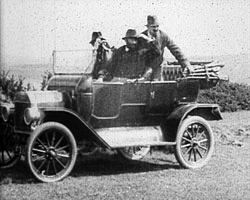 ¶ Walter Harold Speer for Brighton and County Film Company/Brightonia.
¶ Walter Harold Speer for Brighton and County Film Company/Brightonia.
A Nurse's Devotion 1,370ft/23 mins.
—Drama.
The Motor Bandits 1,017ft/17 mins. [right]
—Crime story.
• 1913
¶ Arthur Charrington for Brightonia:
East Lynne
—Melodrama from Mrs Henry Wood's play. Cast: Nell Emerald, Frank E Petley, H Agar Lyons, Monnie Mine and C S McConnell.
The Grip of Iron 3250 ft.
—Based on a play by Arthur Shirley from the novel Les Estrangleurs de Paris by Belot. Cast: Fred Powell, Nell Emerald, H Agar Lyons, Frank E Petley, Gertrude Price, Stanley Bedwell.
• 1912
¶ S T W Johnson
The Royal Pavilion as an Indian Hospital 11 mins.
—Documentary shot on 21 August, includes the rpesentation of the Victoria Cross to Mir Dat by King George V. The film was premiered at the Palladium Cinema, where Johnson was the manager, in October 1915.
• Kinemacolor
With a studio/production base at Cambridge Grove, Hove and a studio at Nice in the south of France, many Kinemacolor films were made and/or released in the period from 1910 to 1912.
¶ Walter R Booth and Theo Frenkel for Natural Colour Kinematograph Company:
The Cap of Invisibility. 9 mins. Released 1 February 1912.
The Hypnotist and the Convict. 8 mins. Released September 1911.
Little Lady Lafayette. 14 mins. Released September 1911.
Mischievous Puck. Monochrome; 13 mins. Released September 1911.
The Modern Pygmalion and Galatea. 9 mins. Released September 1911.
Mystic Manipulations. 15 mins.
Simpkin's Dream of a Holiday. 13 mins. Released 7 December 1911.
Uncle's Picnic. 11 mins. Released September 1911.
The Wizard and the Brigands. 12 mins. Released September 1911.
¶ Theo Frenkel for Natural Colour Kinematograph Company. Filming location of all titles is uncertain but stated below when known not to have been shot in the studio in Hove. It is probable that these films were made in 1910 but released gradually over the following months. All are in Kinemacolor, except where stated:
The Adopted Child. 19 mins. Released December 1911.
The Amorous Doctor. comedy; 2 mins. Released 27 April 1911.
A Balkan Episode. Released 31 August 1911.
The Blackmailer. 19 mins. Released 20 July 1911.
Boys Will Be Boys. 13 mins. Released September 1911.
Brown's German Liver Cure. comedy; 12 mins. Released 8 June 1911.
The Burglar as Father Christmas. drama; 14 mins. Released May 1911.
Caesar's Prisoners
—featuring Frenkel as Julius Caesar and Julie Meijer as The Queen; 14 mins.
Checkmated. 18 mins. Released July 1911.
A Citizeness of Paris. 18 mins.
The Clown's Sacrifice. 17 mins. Released 25 May 1911.
The Crusader. 19 mins. Released 6 April 1911.
Dandy Dick of Bishopsgate. 19 mins. Released 16 November 1911.
Detective Henry and the Paris Apaches. 14 mins. Released 15 June 1911.
A Devoted Friend. 19 mins. Released 29 June 1911.
An Elizabethan Romance. 16 mins. Released 8 February 1912.
Ester: A Biblical Episode. 19 mins.
The Fall of Babylon
—featuring Frenkel as Belshazzar, with Julie Meijer; 17 mins. Released 18 May 1911.
The Fisherman's Daughter. 17 mins. Released November 1911.
Following Mother's Footsteps (alt title: In His Mother's Footsteps. comedy; 16 mins. Released 4 May 1911.
For the Crown. 20 mins.
The Flower Girl of Florence. 19 mins. Released 1 June 1911.
A French Duel. 14 mins. Released 1 June 1911.
From Factory Girl to Prima Donna. 16 mins. Released 30 March 1911.
Galileo. 17 mins. Released July 1911.
A Gambler's Villainy. 12 mins. Released 15 February 1912.
The General's Only Son. 19 mins. Released 7 December 1911.
Gerald's Butterfly. 8 mins. Released 11 January 1912.
The Highlander. romance; 18 mins. Released 2 March 1911.
His Conscience. crime drama; 19 mins. Released 13 April 1911.
His Last Burglary. crime drama; 15 mins. Released 8 June 1911.
In the Reign of Terror. 17 mins. Released 27 July 1911.
The Inventor's Son. 19 mins. Released 28 December 1911.
Jane Shore. adapted from a play by Nicholas Rowe. Released 2 November 1911.
Johnson at the Wedding. comedy; 17 mins. Released 21 September 1911.
Julius Caesar's Sandals. Monochrome. Released 19 October 1911.
Kinemacolor Songs (alt titles Kitty of Coleraine, Simon the Cellarer. Released May 1911.
The King of Indigo. comedy; 10 mins. Released 9 March 1911.
Kitty the Dressmaker. romance; 16 mins. Released March 1911.
Lady Beaulay's Necklace. crime drama; 19 mins. Released 6 April 1911.
The Little Daughter's Letter. 16 mins. Released 31 August 1911.
The Little Wooden Soldier. 28 mins. Released 4 January 1912.
The Lost Ring (alt title Johnson's Honeymoon). comedy; 14 mins. Released 25 March 1911.
Love in a Cottage. Monochrome, comedy; 19 mins. Released 21 September 1911.
Love of Riches. Monochrome; 19 mins. Released December 1911.
Love Story of Charles II. 18 mins. Released November 1911.
Love's Strategy. comedy; 19 mins. Released November 1911.
A Lucky Escape. Monochrome, comedy; 15 mins. Released 23 November 1911.
The Lust for Gold
—featuring Frenkel as King Midas, with Julie Meijer. Released 18 April 1912.
The Magic Ring. Monochrome, comedy; 15 mins. Released 28 December 1911.
The Mighty Dollar. Released 30 May 1912.
The Minstrel King. 20 mins. Released 11 January 1912.
A Modern Hero. crime drama; 13 mins. Released 13 April 1911.
Music Hath Charms. 14 mins. Released October 1911.
The Millionaire's Nephew. Monochrome; 15 mins. October 1911.
Nell Gwynn the Orange Girl. 19 mins. Released 21 December 1911.
A Noble Heart. 19 mins. Released 17 August 1911.
Ofia, the Woman Spy
—featuring Frenkel and Julie Meijer as Ofia. Released 6 June 1912.
The Old Guitar. 20 mins. Released 25 January 1912.
Oliver Cromwell. 18 mins. Released November 1911.
Only a Woman
—featuring Frenkel as Dennis. Released 25 April 1912.
The Passions of an Egyptian Princess
—featuring Julie Meijer as Cleopatra; 14 mins.
The Peasants and the Fairy. 16 mins.
The Priest's Burden. 16 mins. Released 14 December 1911.
The Rebel's Daughter. 17 mins. Released 11 April 1911.
Romani, the Brigand
—featuring Frenkel and Julie Meijer. Released 18 April 1912.
Samson and Delilah. 15 mins. Released 27 July 1911.
A Seaside Comedy. comedy; 15 mins. Released 4 January 1912.
The Silken Thread. 14 mins.
Swank and the Remedy. 17 mins. Released 11 May 1911.
Telemachus. costume drama; 16 mins. Released 18 May 1911.
The Tide of Fortune. 20 mins. Released 18 January 1912.
La Tosca
—adapted from Victorien Sardou's play, featuring Lillian Russell; 30 mins. May have been shot in the USA.
A Tragedy of the Olden Times (alt titles: A Story of the Olden Times, In the Olden Time. Monochrome crime drama.
Trilby and Svengali. adapted from George du Maurier's novel, featuring Frenkel as Svengali and Julie Meijer as Trilby. 17 mins.
A True Britton [sic]. 19 mins. Released 1 February 1912.
Two Can Play at the Same Game. comedy; 14 mins. Released 15 June 1911.
The Two Chorus Girls. romance; 13 mins. Released 27 April 1911.
Two Christmas Hampers. 20 mins. Released 30 November 1911.
The Two Rivals. 14 mins. Released 11 January 1912.
The Vandal Outlaws
—featuring Julie Meijer as The Baroness; 36 mins. Released 18 April 1912.
The Vicissitudes of a Top Hat. 16 mins. Released 18 January 1912.
¶ Theo Frenkel as Theo Bouwmeester for Natural Colour Kinematograph Company:
Fate
—western, shot on location in Sussex; 19 mins. Released 4 May 1911.
Love Conquers. Romance.
¶ F Percy Smith, natural history filming pioneer, who became the first doyen of the genre, for Natural Colour Kinematograph Company:
The Birth of Spring Flowers 1,140ft.
The Freshwater Aquarium 960ft.
From Bud to Blossom 1,025ft.
Gems and Jewels 960ft.
Scenes at the London Zoo 1,205ft.
Varieties of Sweet Peas 850ft.
¶ G A Smith for Natural Colour Kinematograph Company in Kinemacolor:
Beads of the World 775ft.
¶ G A Smith (among others) for Natural Colour Kinematograph Company in Kinemacolor at various locations away from Brighton and Hove:
Aeroplanes and Birdmen 635ft.
All British Fashions Exhibition 410ft.
Arrival of the Canadian Troops 320ft.
Athletic Meeting at The Queen's Club 450ft.
Badger Hunting at Cublington 795ft.
Beach Drill at Hastings 670ft.
Boy Scouts at Windsor 600ft.
British Motor-boat Racing 1,020ft.
Canadian Troops in London 235ft.
Children's Empire Day Procession 245ft.
Children's Empire Day Review 885ft.
The Coronation Derby 1,165ft.
Coronation Drill at Reedham Orphanage 715ft.
The Coronation Procession as Seen from the Mall 715ft.
The Coronation Procession in Parliament Square 585ft.
The Coronation Procession: Returning After the Crowning 585ft.
The Coronation Procession: Trafalgar Square 425ft.
A Country Fair 700ft.
Cowes During Regatta Week 770ft.
A Day at Henley 1,060ft.
Disguising London 700ft.
Edinburgh During the Visit of the King and Queen 745ft.
Eton Day on the Thames 680ft.
Feeding Poultry on the Prowse-Jones Farm 190ft.
Festival Fete of the Royal Seamen's Orphanage 575ft.
Foreign Officers' Jumping Practice 280ft.
High Jumping 575ft.
Improved Methods of Agriculture 630ft.
Incidents of the £400 Golf Tournament 615ft.
Inspection of the Horses of the City of London Corporation 565ft.
Investiture of the Prince of Wales with the Order of the Garter 1,125ft.
The King Receiving Address and Knighting the Mayor of Windsor 295ft.
The King Reviewing Troops at Phoenix Park 295ft.
The King's Reception at Slough Station 305ft.
Launch of HMS King George V 435ft.
Leviathan of the Deep: SS Olympic 425ft.
London: City Coronation Illuminations 215ft.
London One Day Before the Coronation 325ft.
Man's Best Friend 1,080ft.
Marathon and Coaching Meets 575ft.
Miss Lily Smith's Swim in the Solent 610ft.
Mr Walter Winan's Entries for the Royal Horse Show 430ft.
Molesey Regatta 230ft.
The Mop Fair at Stratford-on-Avon 470ft.
Nobility Leaving Chelsea for Westminster 390ft.
Normal London 1,385ft.
On an English Goat Farm 600ft.
Otter Hunt Without a Kill 580ft.
Pageantry Episodes of English History 890ft.
Preparing Camps for the Arrival of the Troops 150ft.
The Regalia Procession 245ft.
Review of the Army Officers' Training Corps 830ft.
Review of the Troops Before King and Kaiser 505ft.
Royal Drive to the Crystal Palace 450ft.
The Royal Horse Show 1,100ft.
The Royal Navy Review 1,160ft.
The Royal Progress: The King Receiving the City Sword 380ft.
The Royal Progress from St Martin's Church 2,010ft.
The Royal Progress in Hyde Park 360ft.
The Royal Progress in Parliament Square 760ft.
The Royal Regatta at Cowes 1,250ft.
The Royal Visit to Ireland 1,065ft.
Rule Britannia 165ft.
Saturday Afternoon at the Hurlingham Club 370ft.
Scenes Along the Jersey Coast 705ft.
Scenes at the Prowse-Jones Garden Party 485ft.
Scenes at the Royal Agricultural Show 470ft.
Scenes in the Indian Camp at Hampton Court 995ft.
State Ceremonies at the Death of King Edward VII series
Strange Mounts 1,585ft.
—features A H Wingfield's private menagerie at his home, Ampthill House, Bedfordshire; keepers are seen riding unusual animals
Their Majesties' Visit to the City 750ft.
Their Majesties' Visit to the City Guildhall 775ft.
Trooping the Colour 455ft.
Unveiling of the Queen Victoria Memorial 1,145ft.
Watchdogs of the World 1,170ft.
Wedding of Captain Betren and Madame Denisoff 310ft.
Yarmouth Herring Industry 1,170ft.
Regular film-making in Brighton now ceases and the centre of south coast production moves to Shoreham.  Films made in Shoreham Films made in Shoreham
Information about other productions not listed here would be welcomed. |

